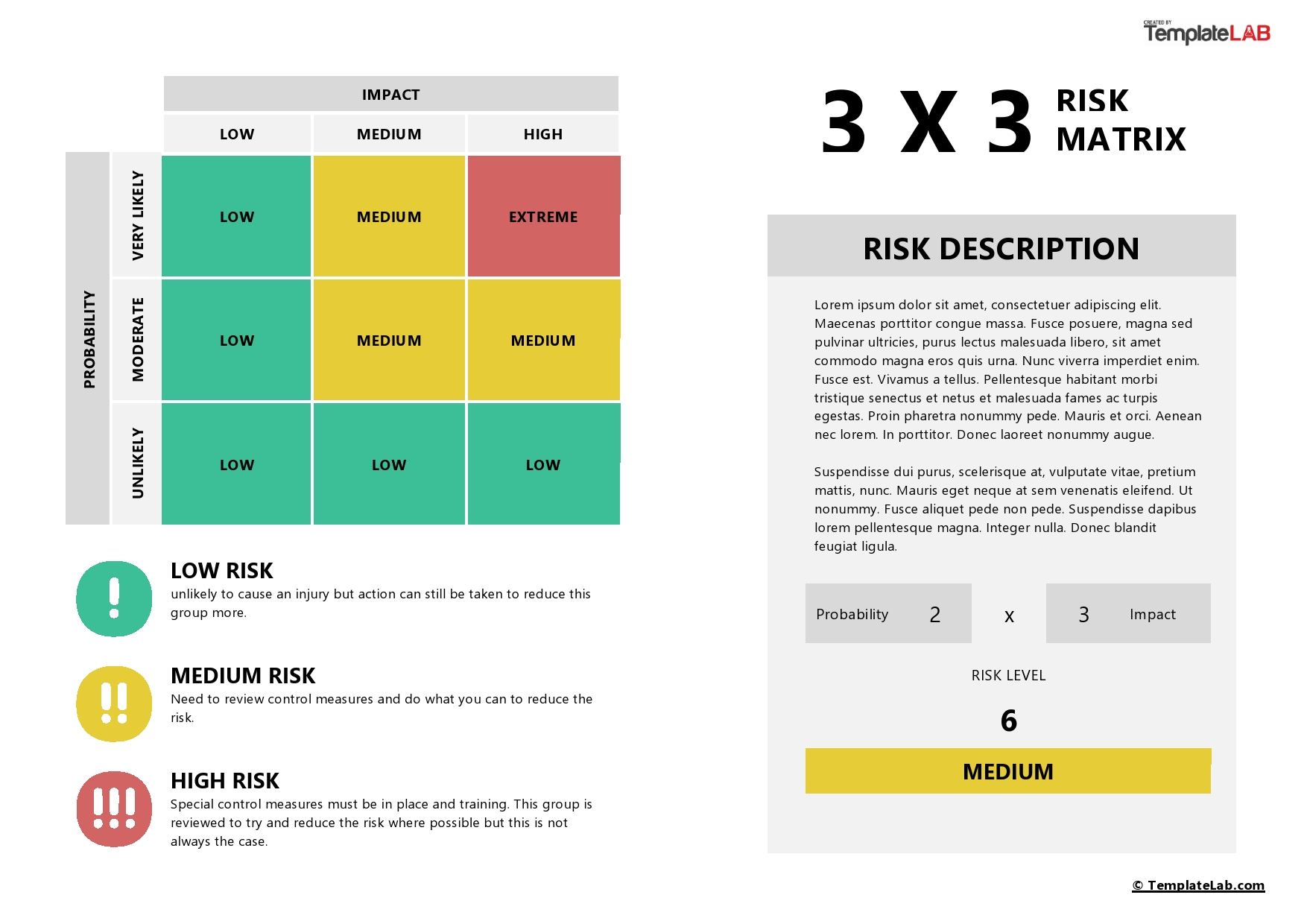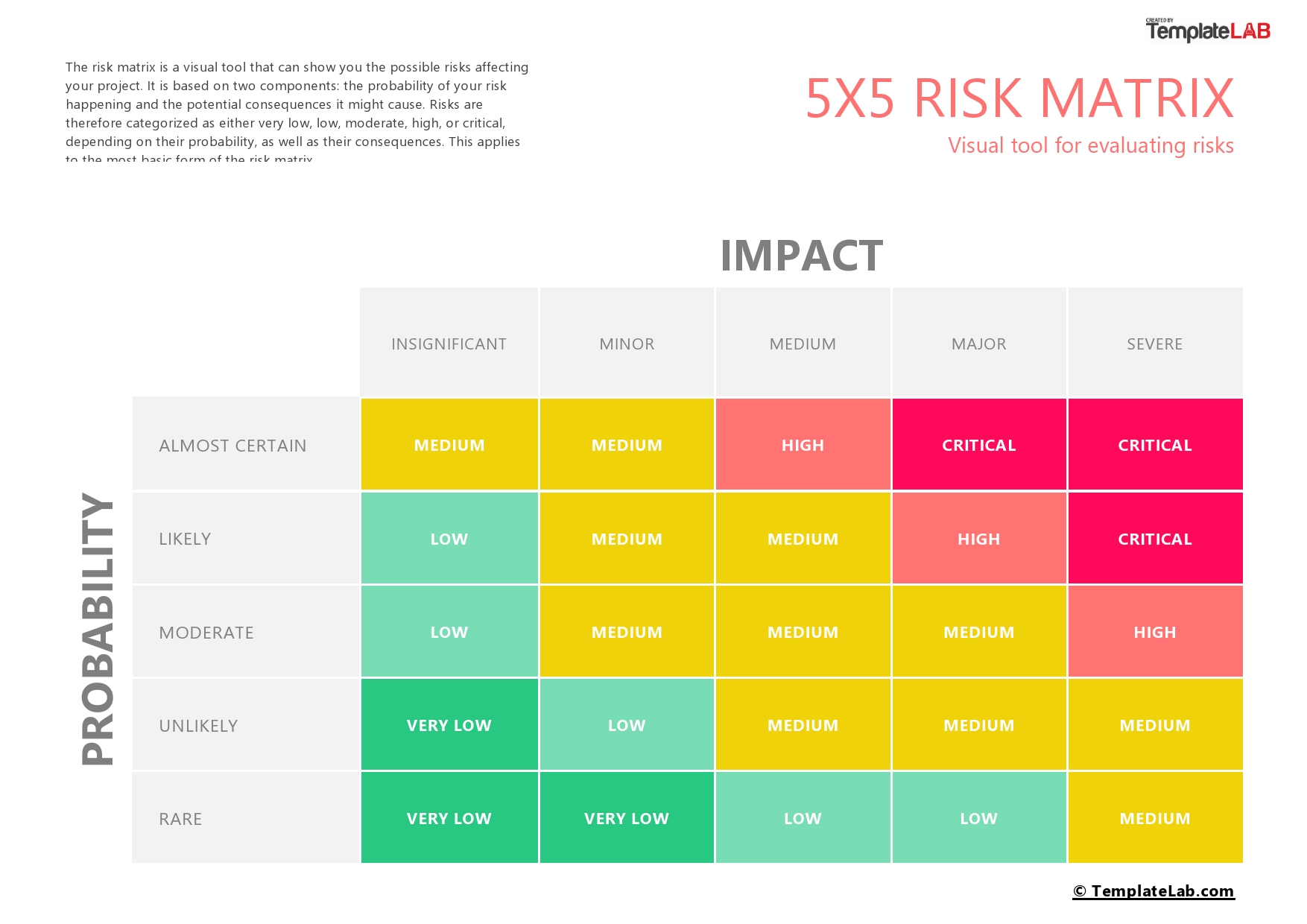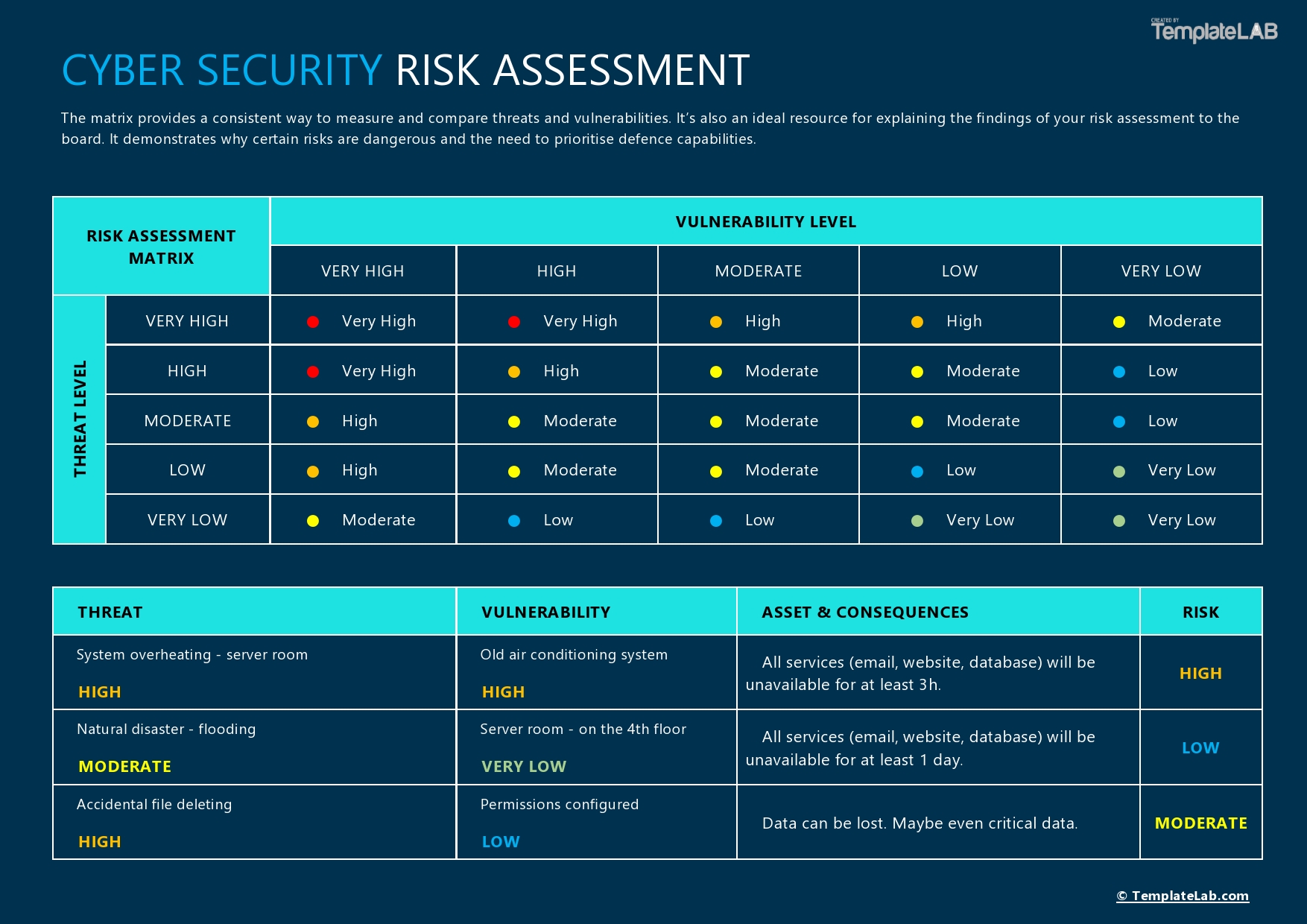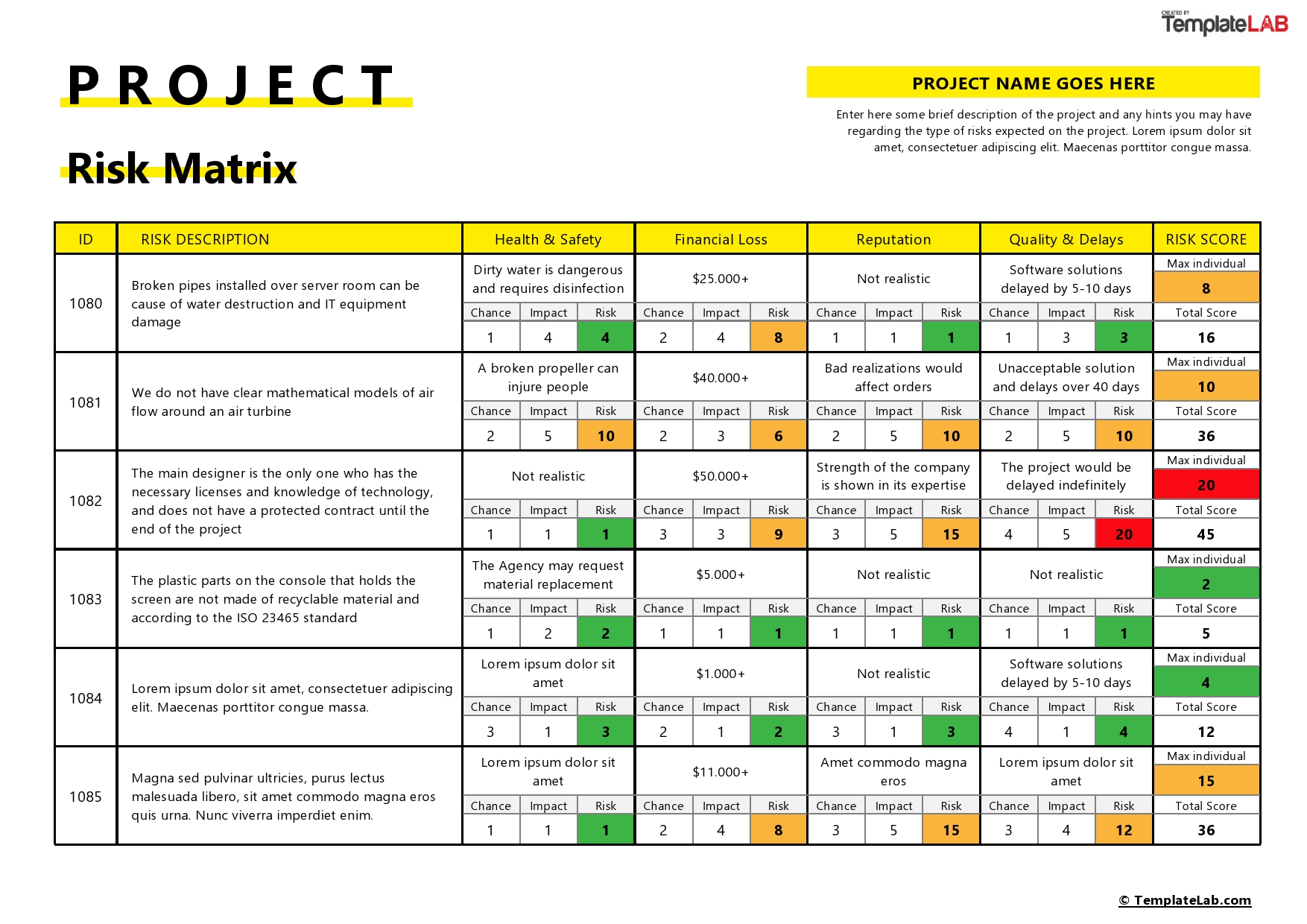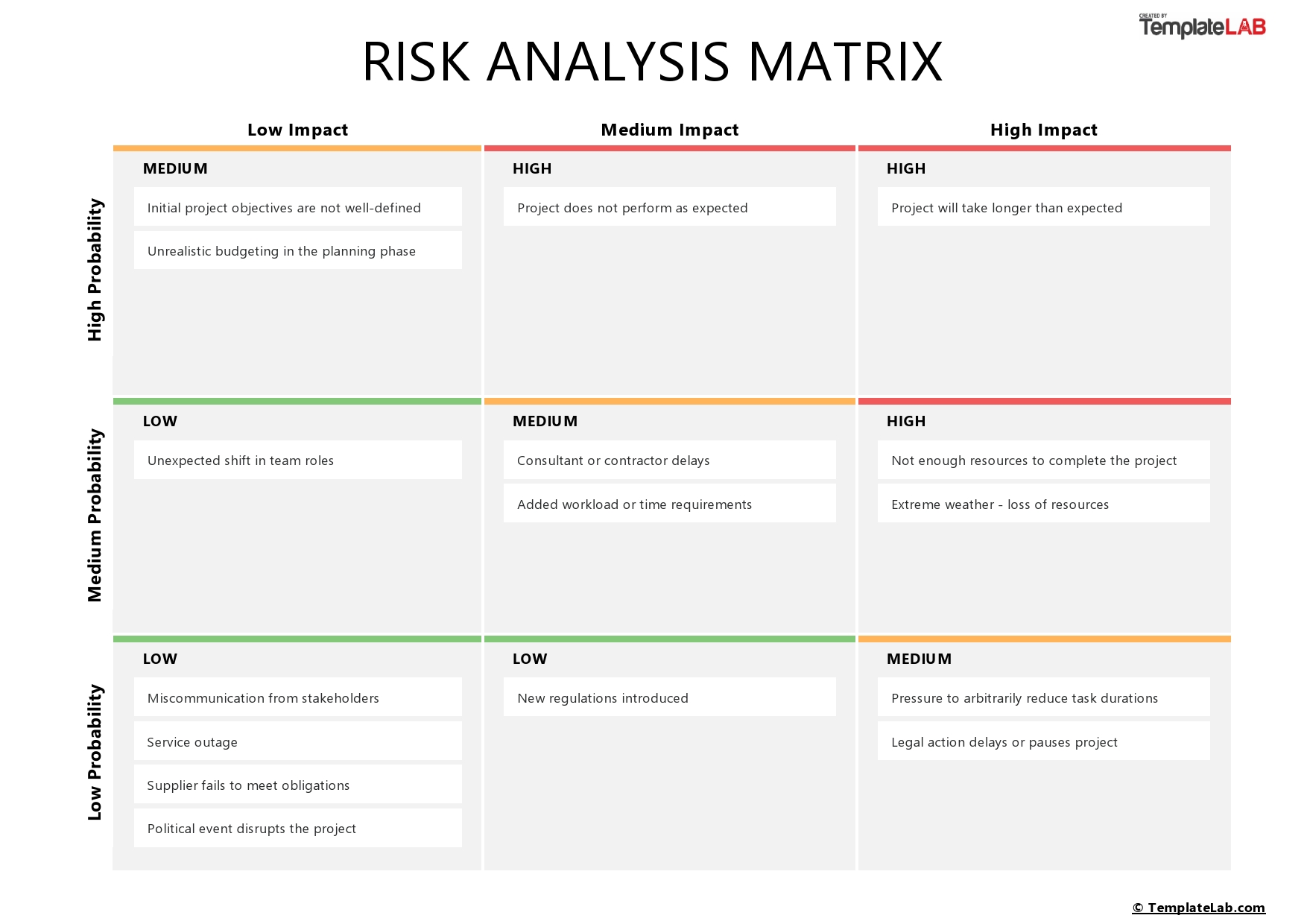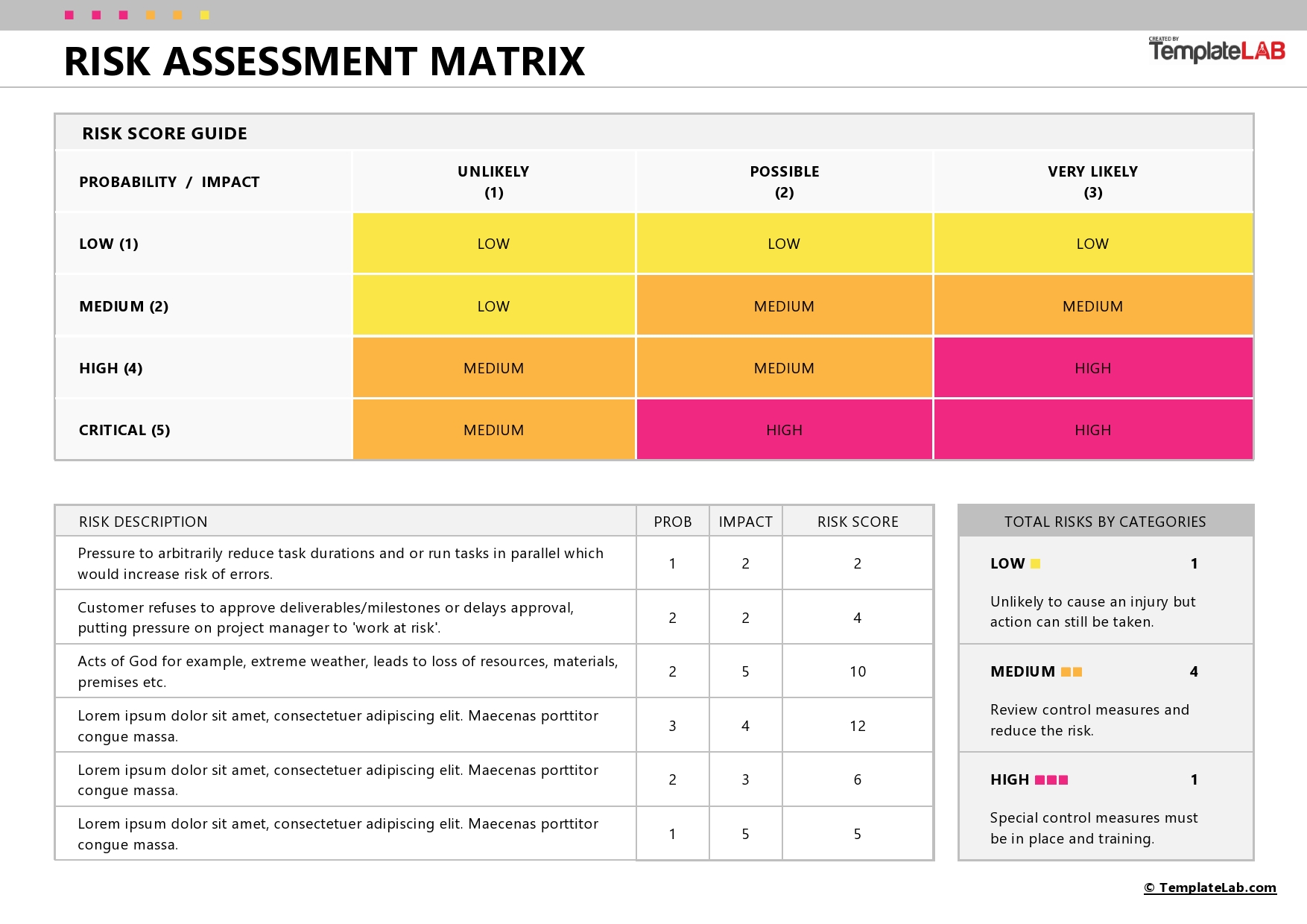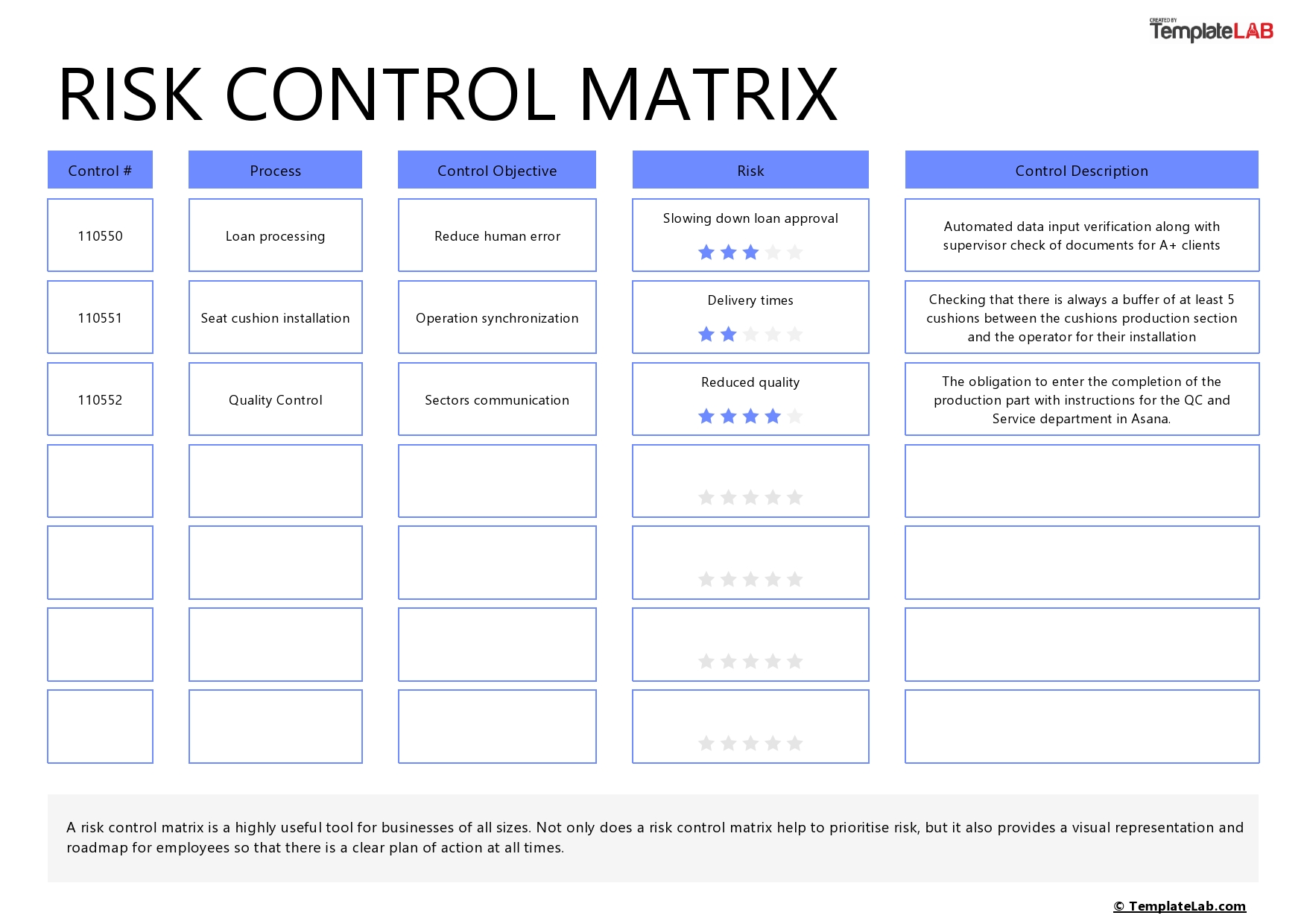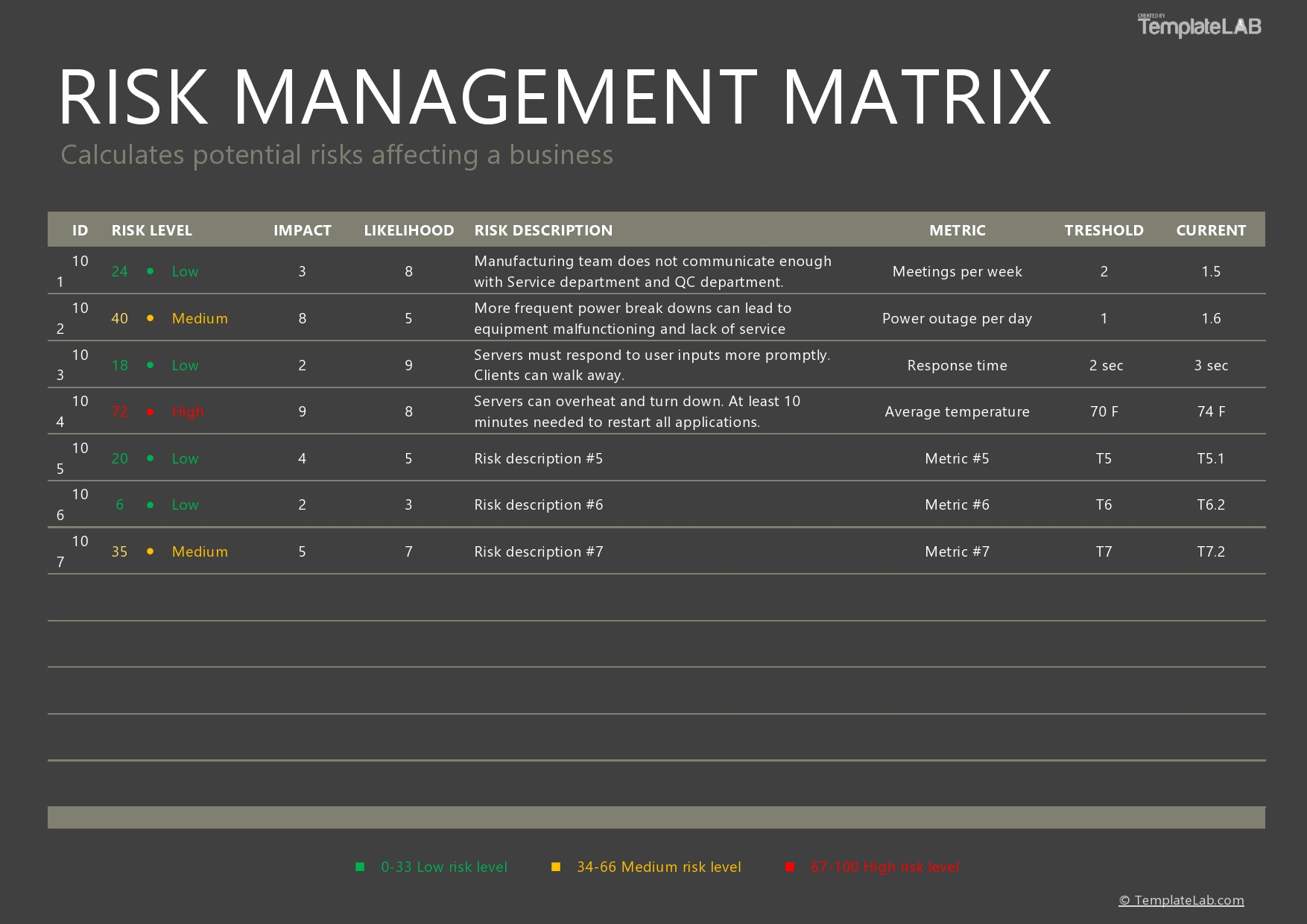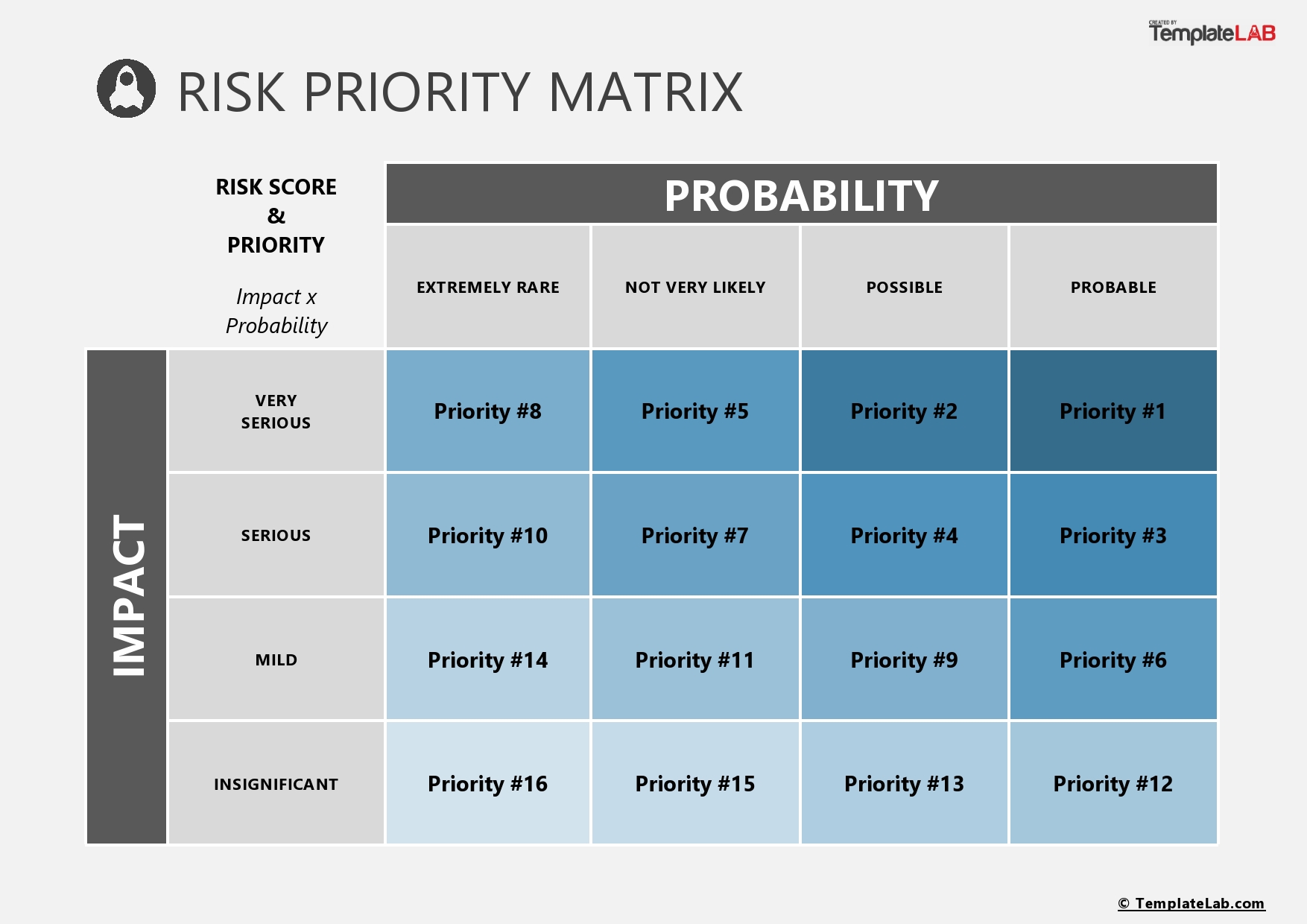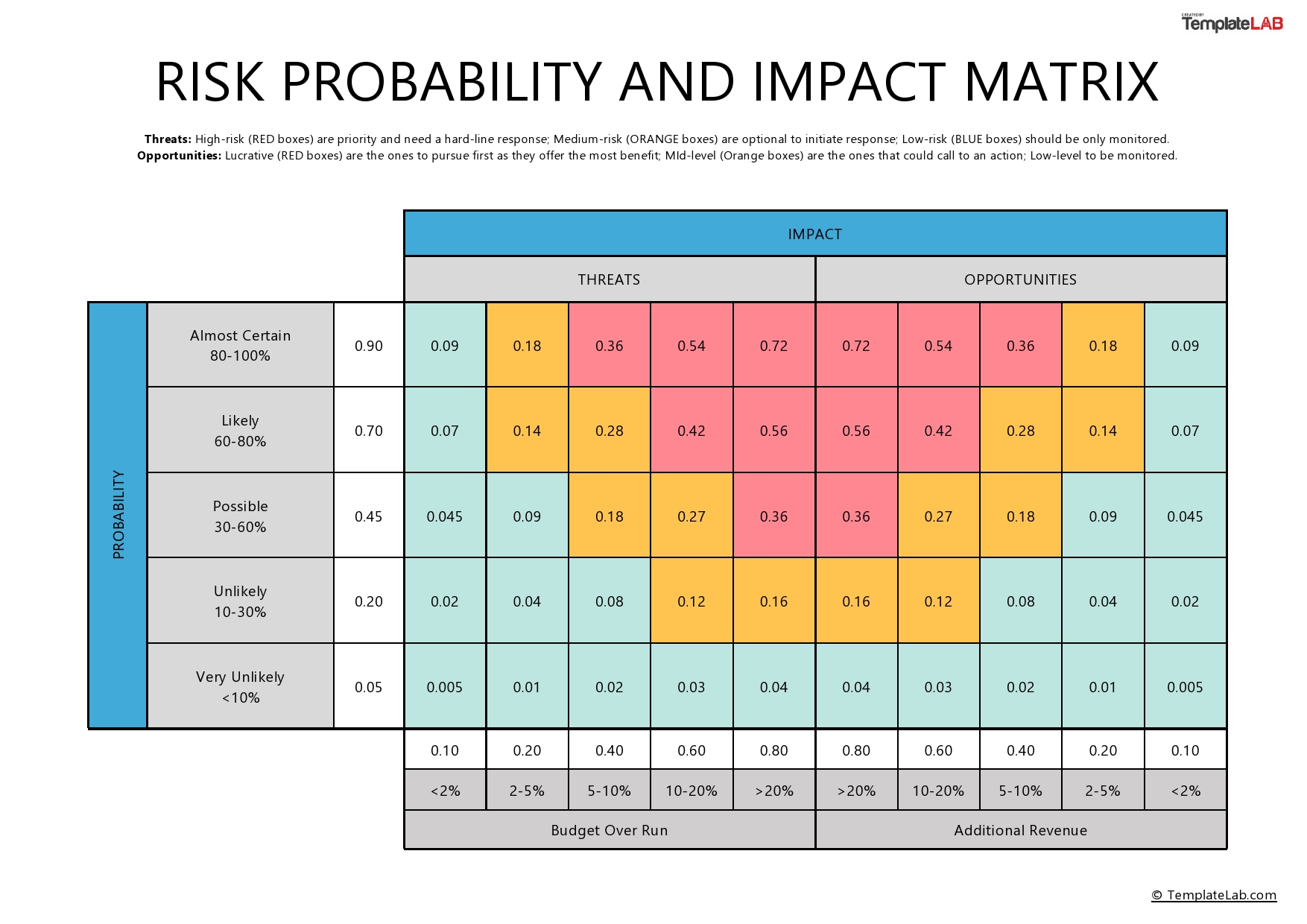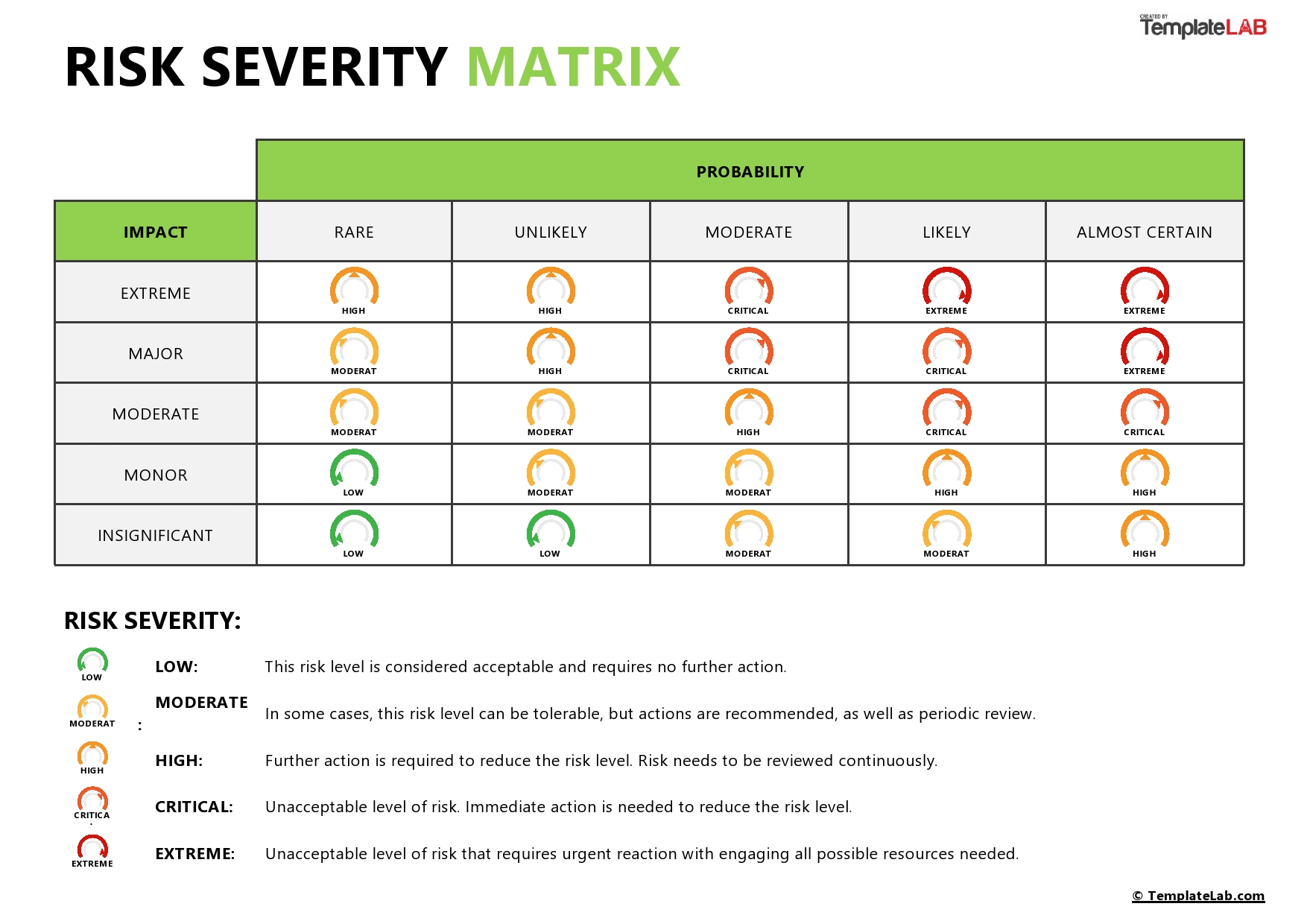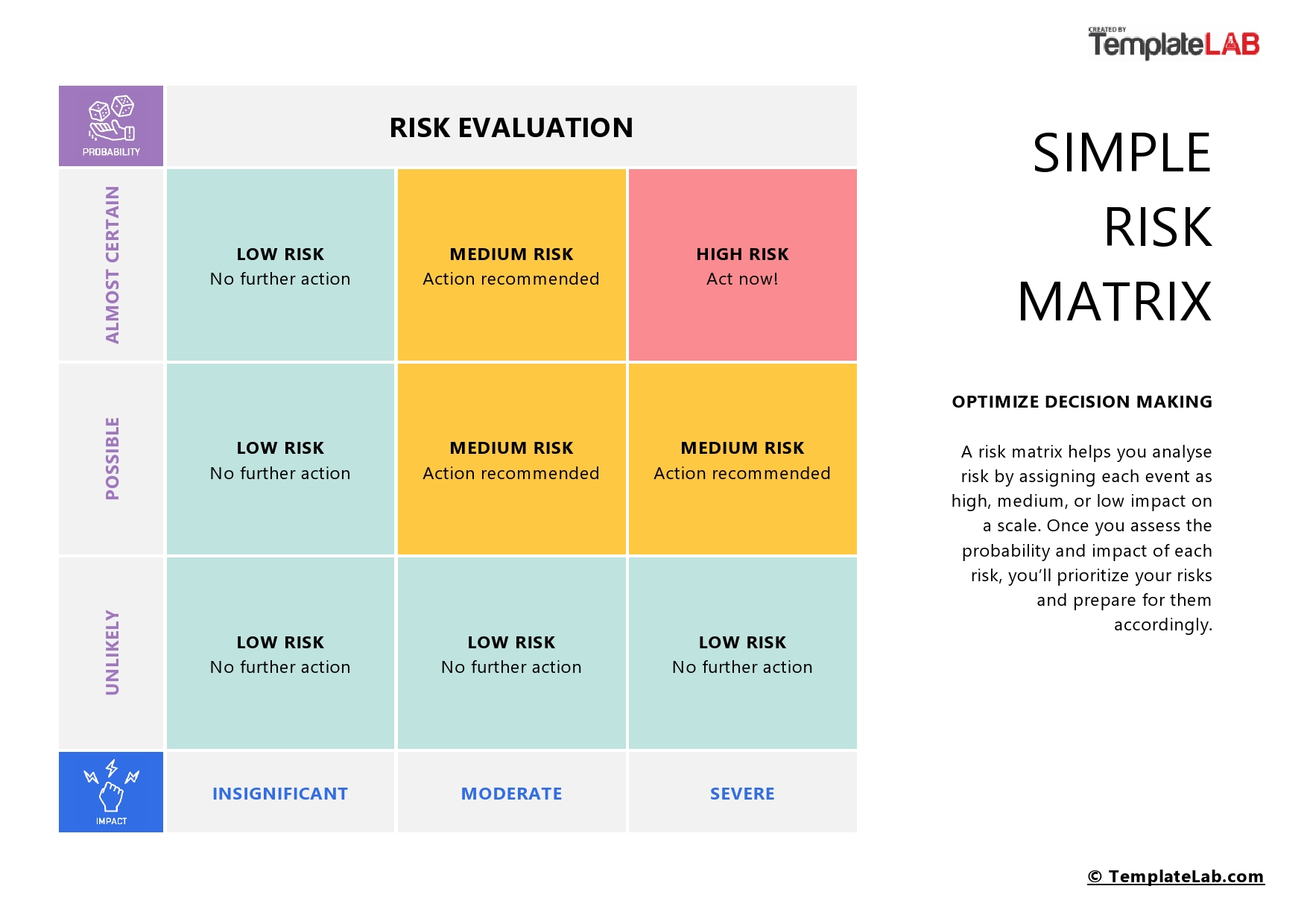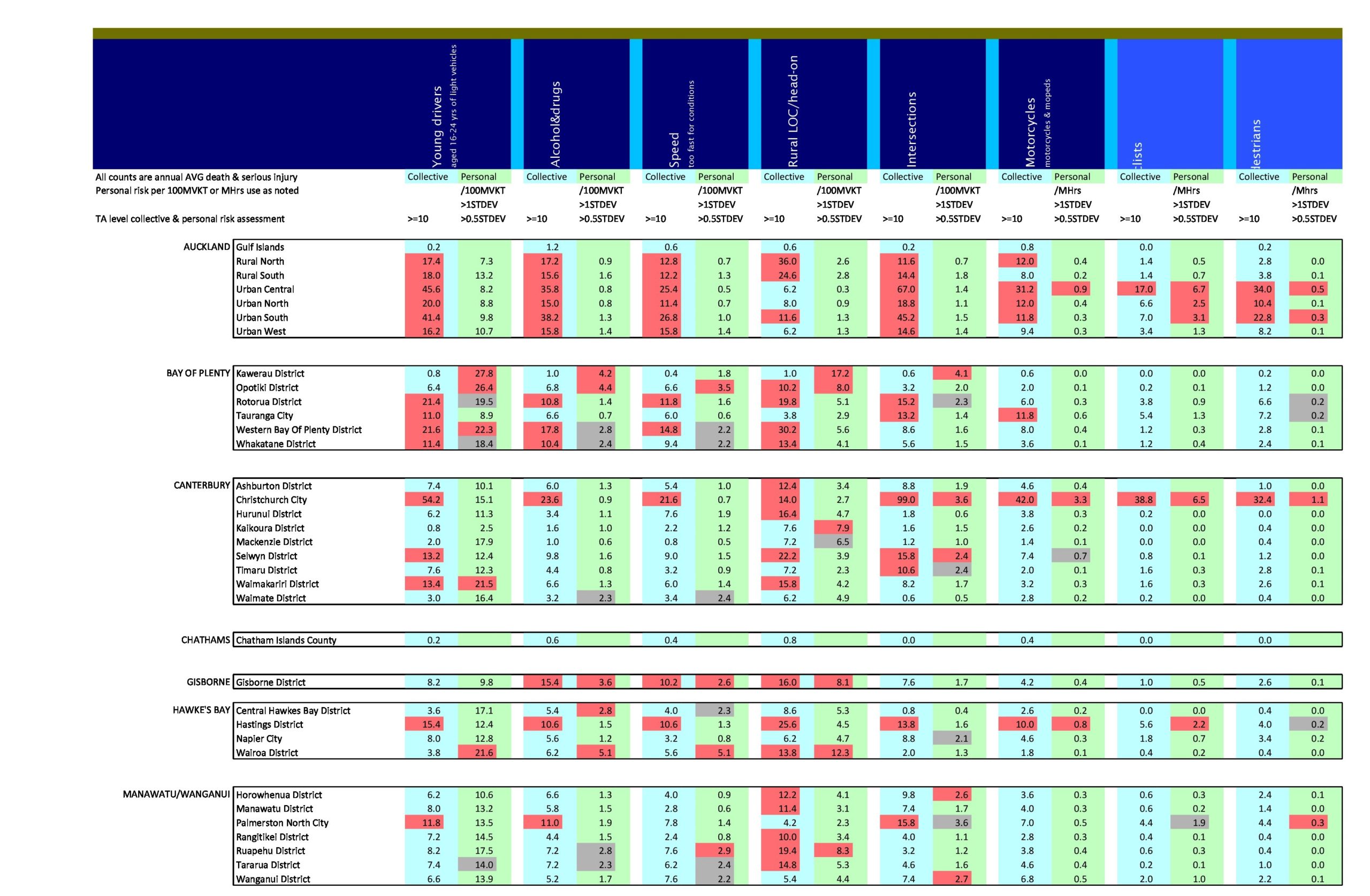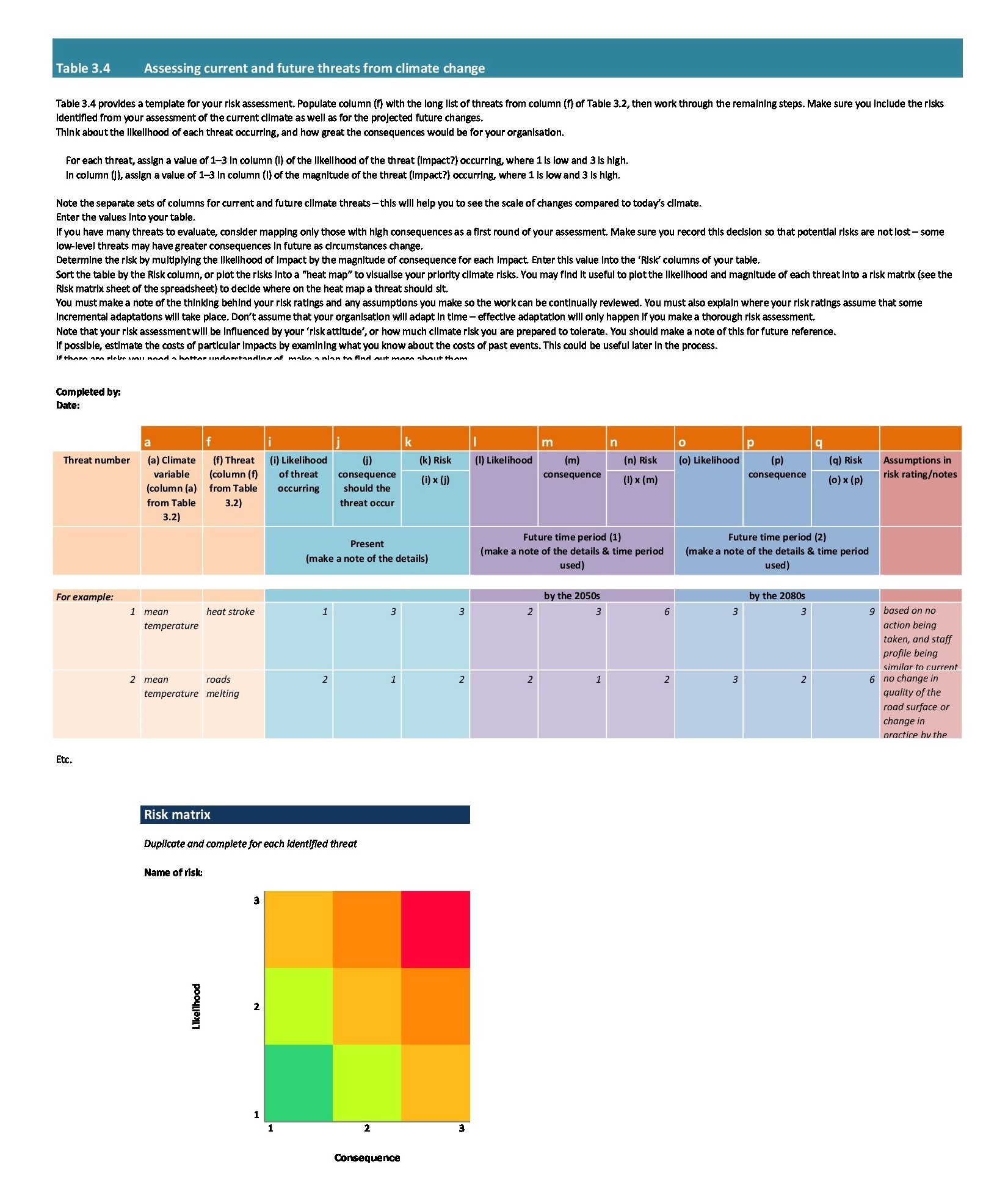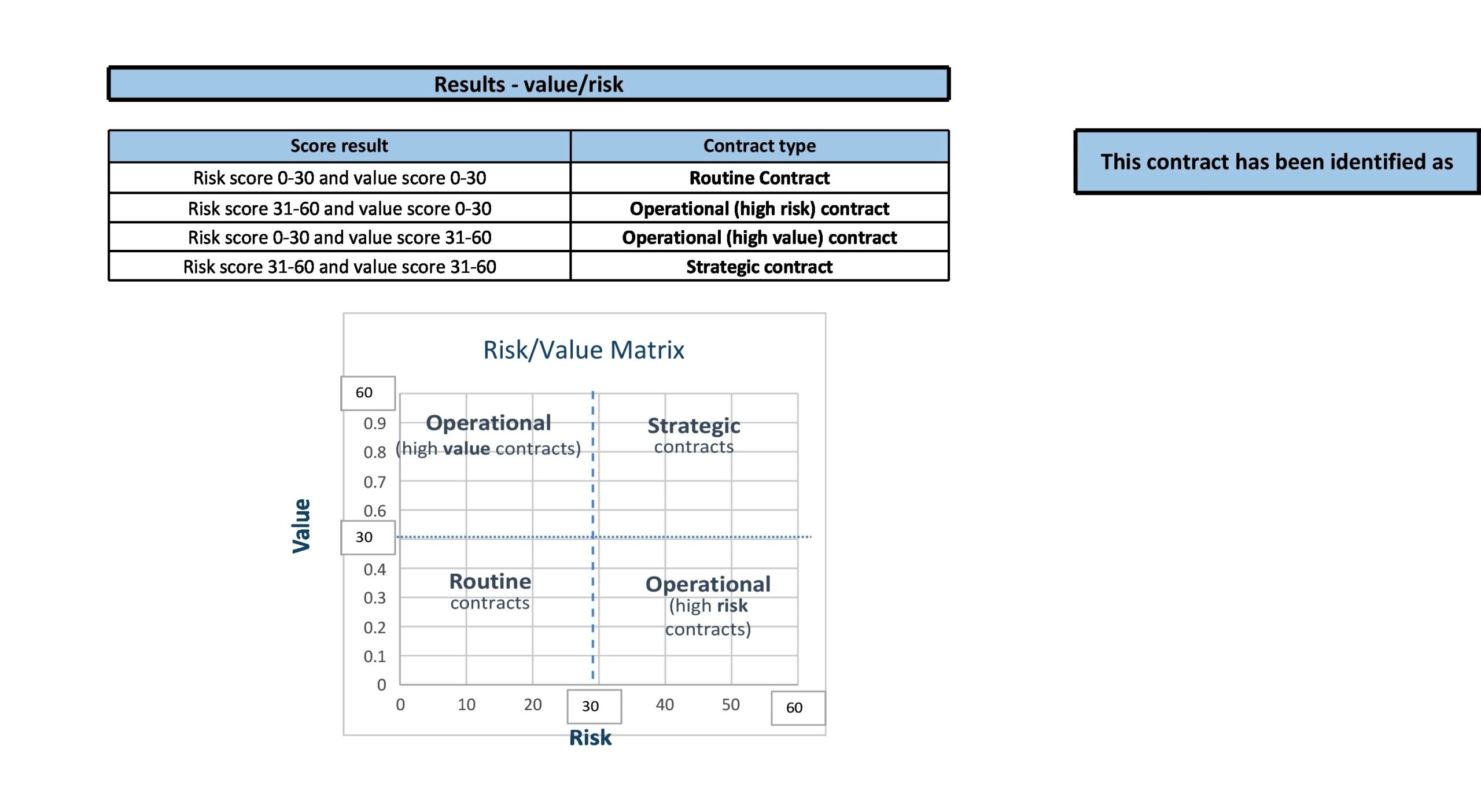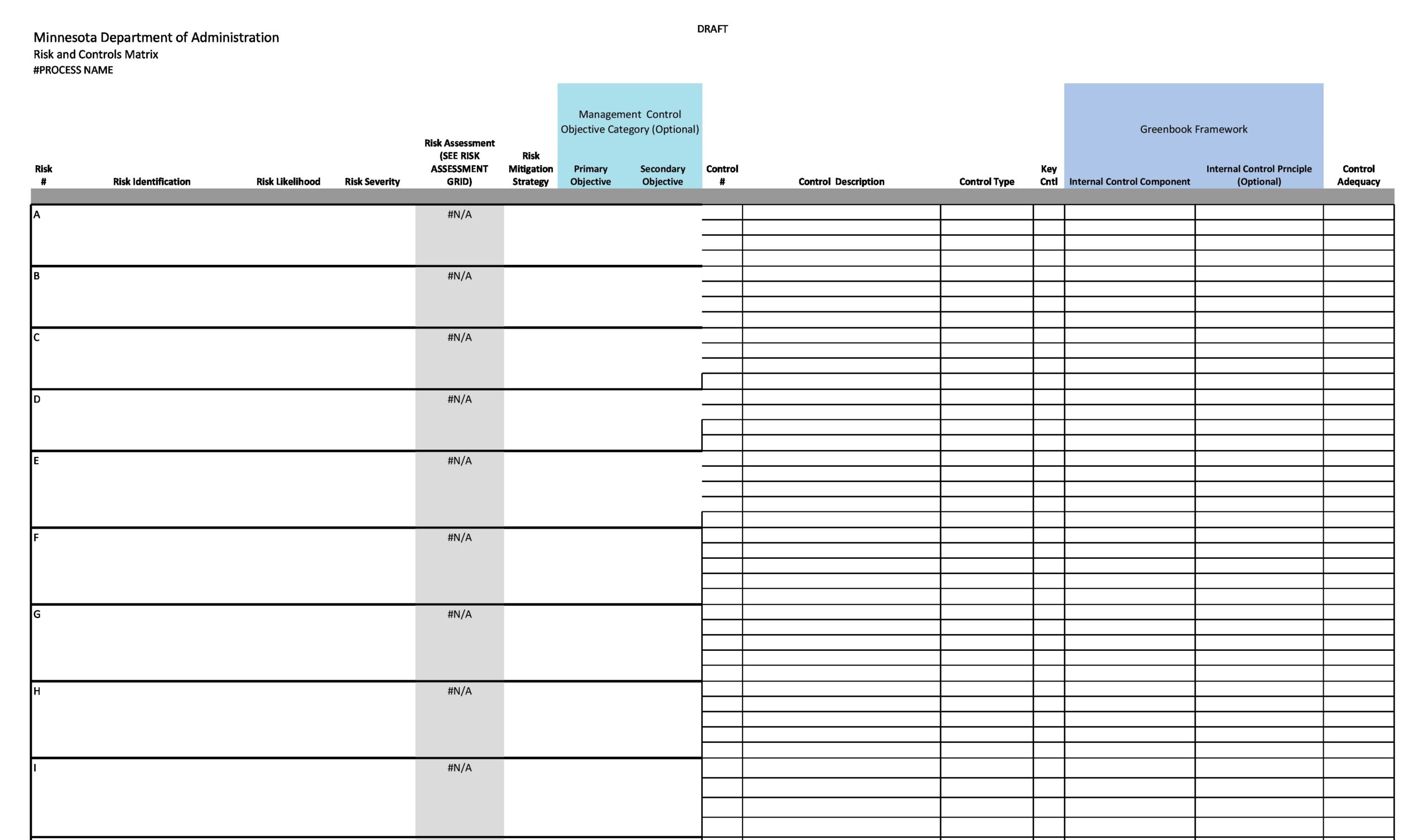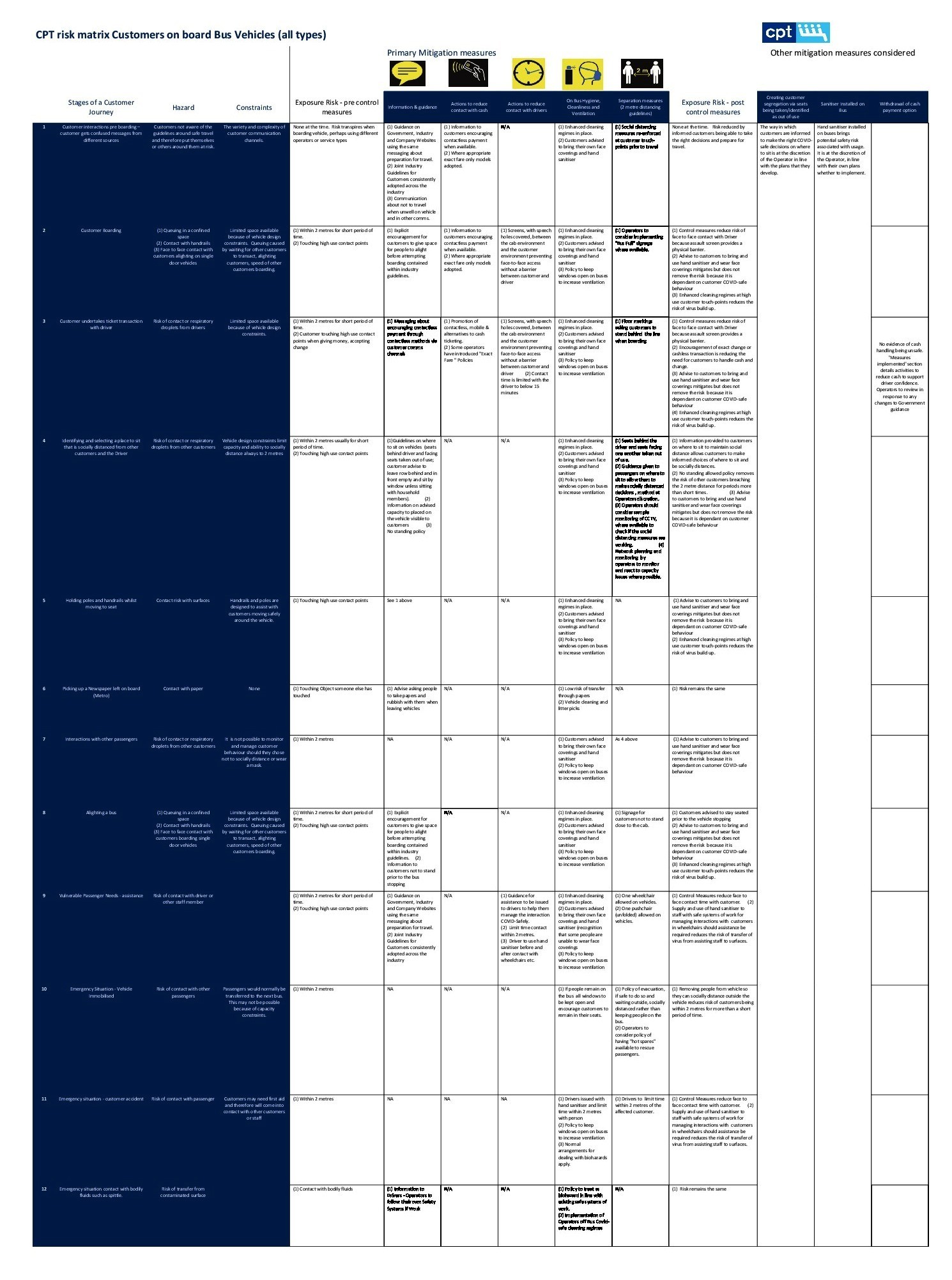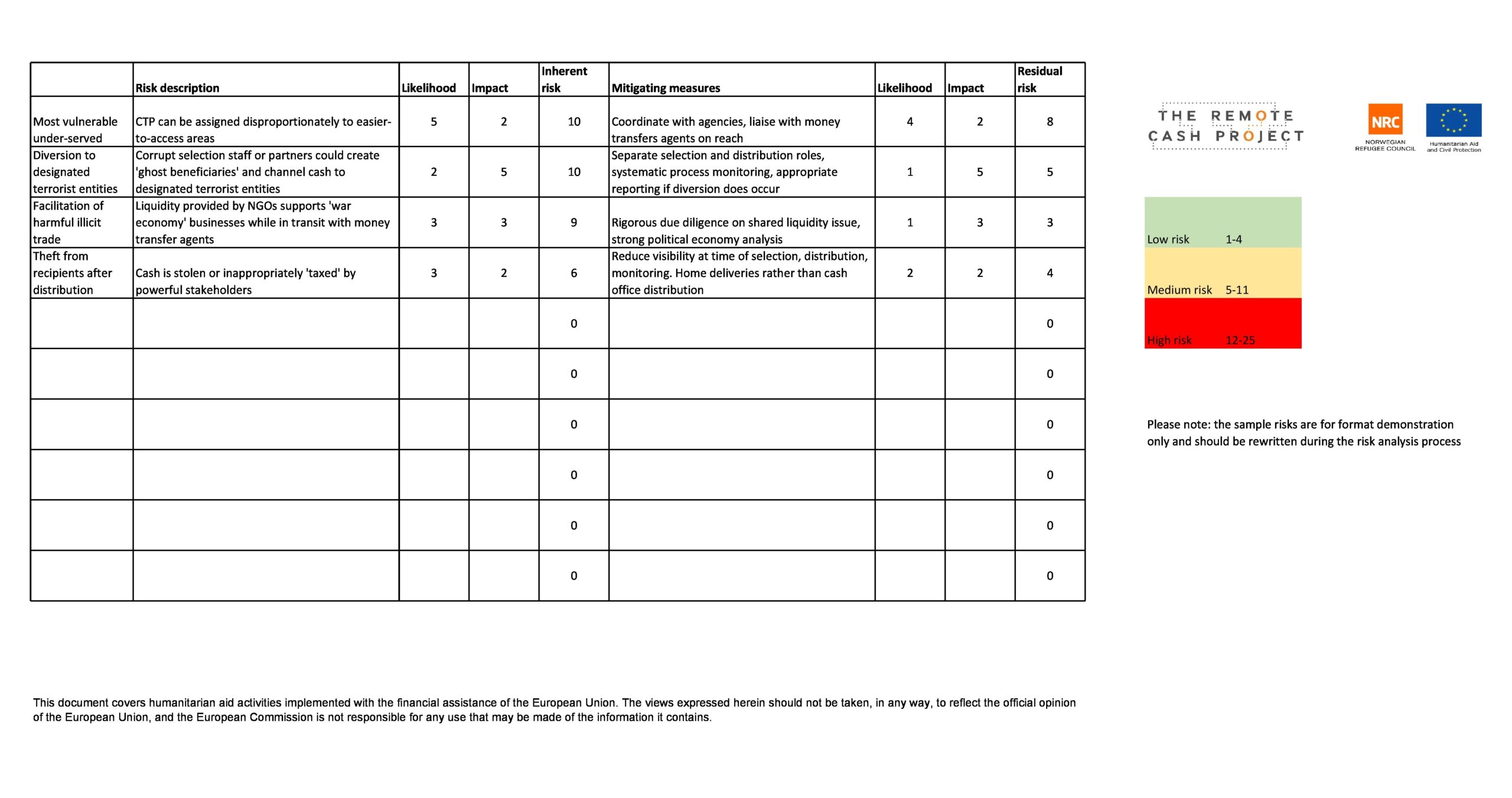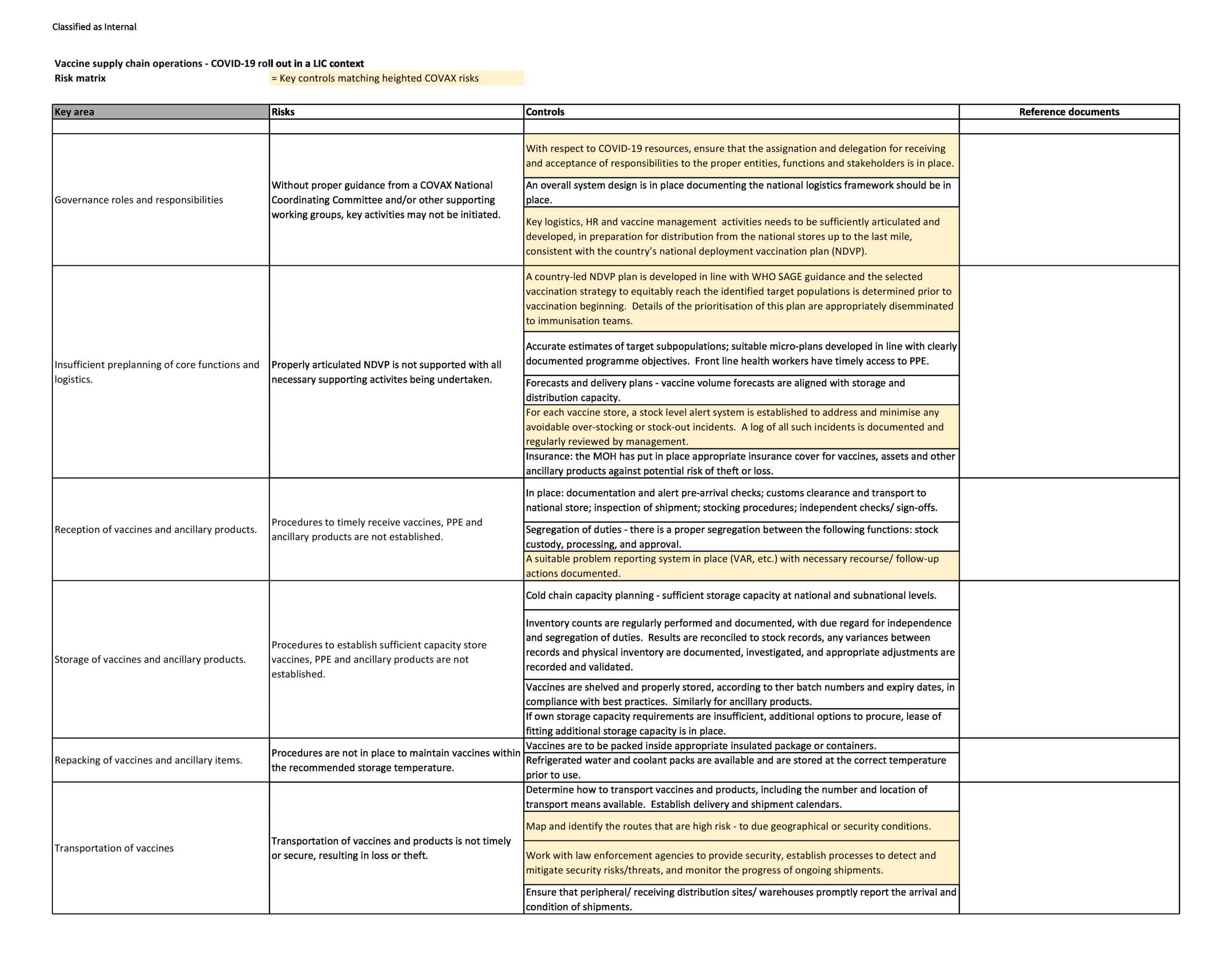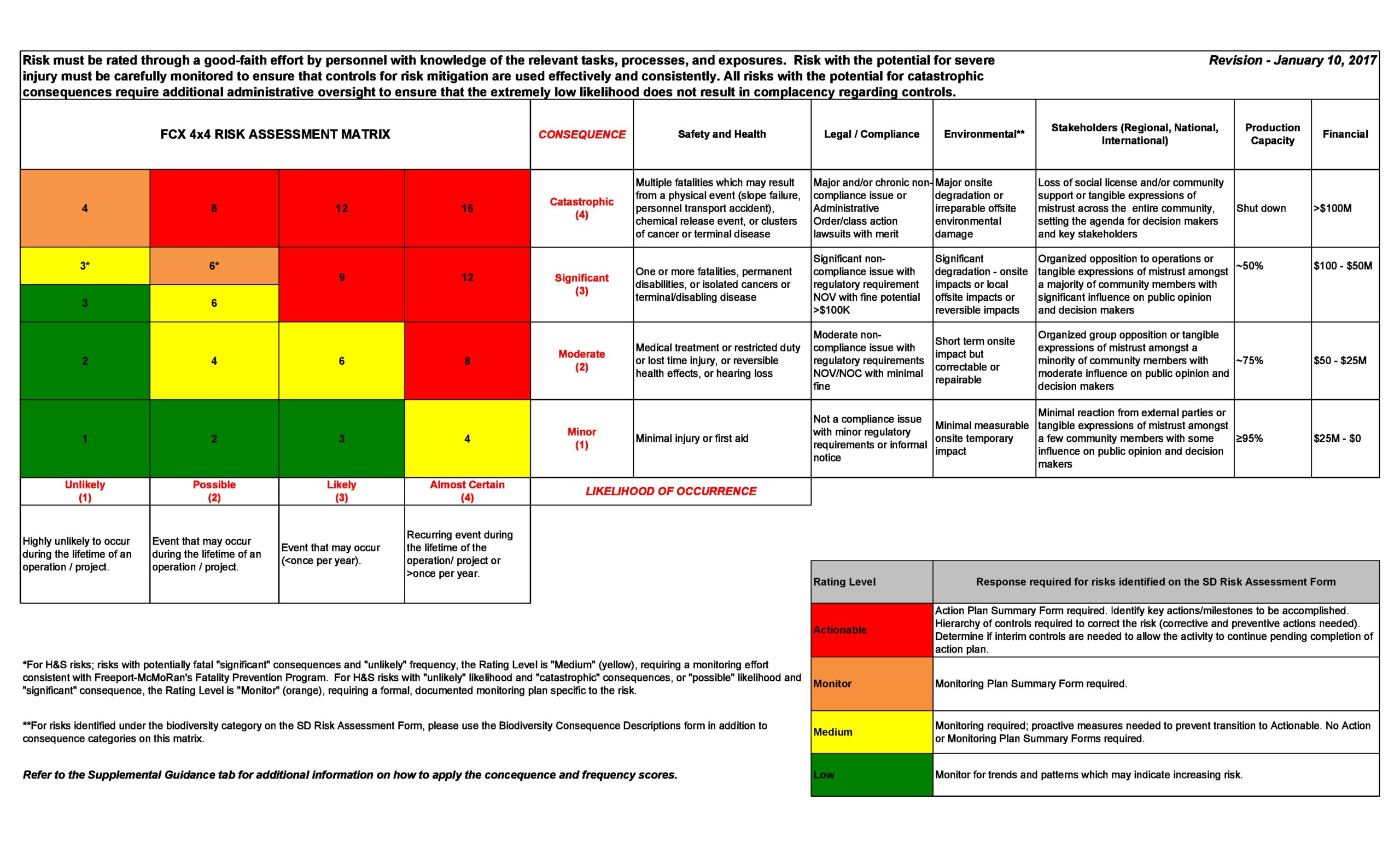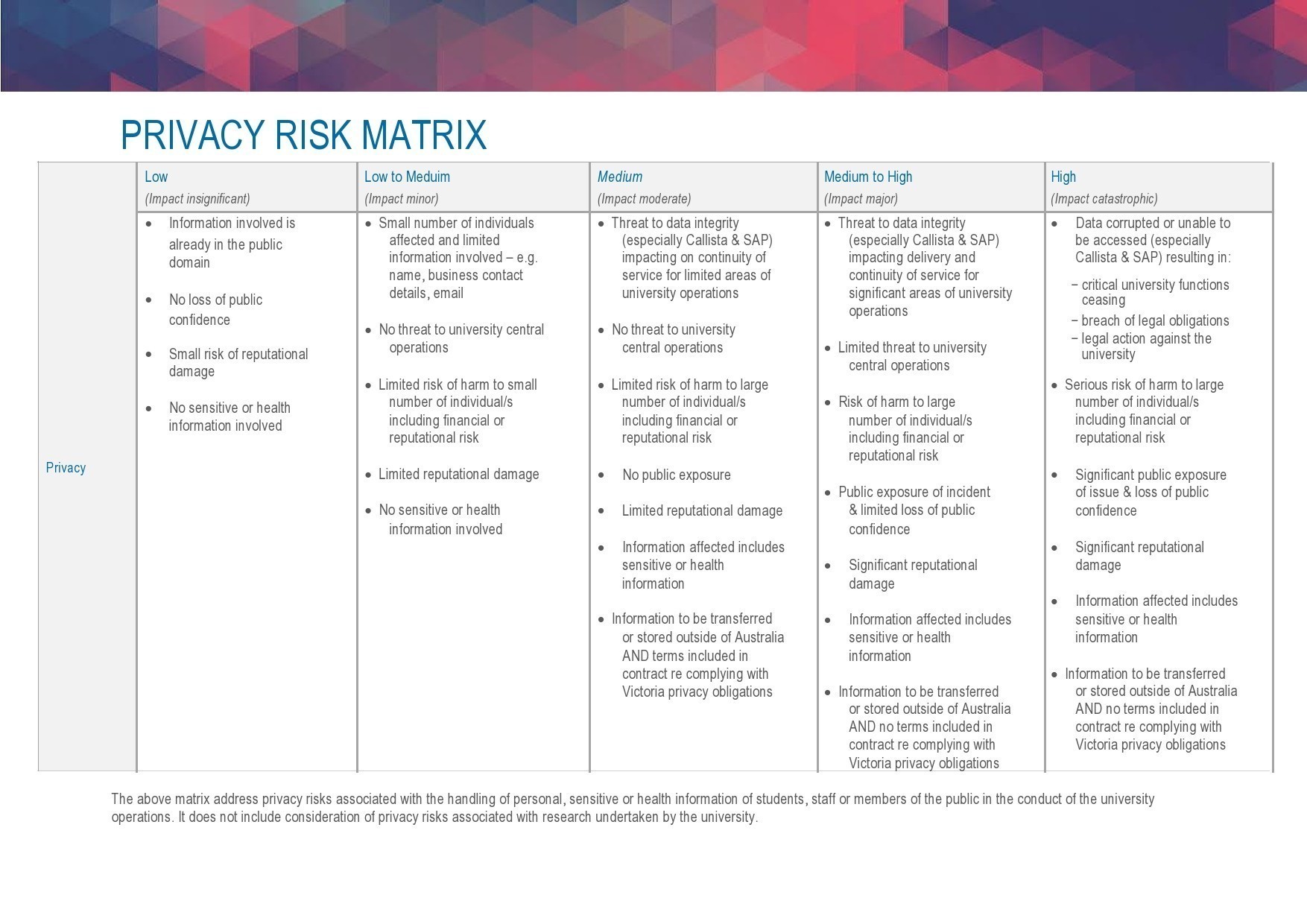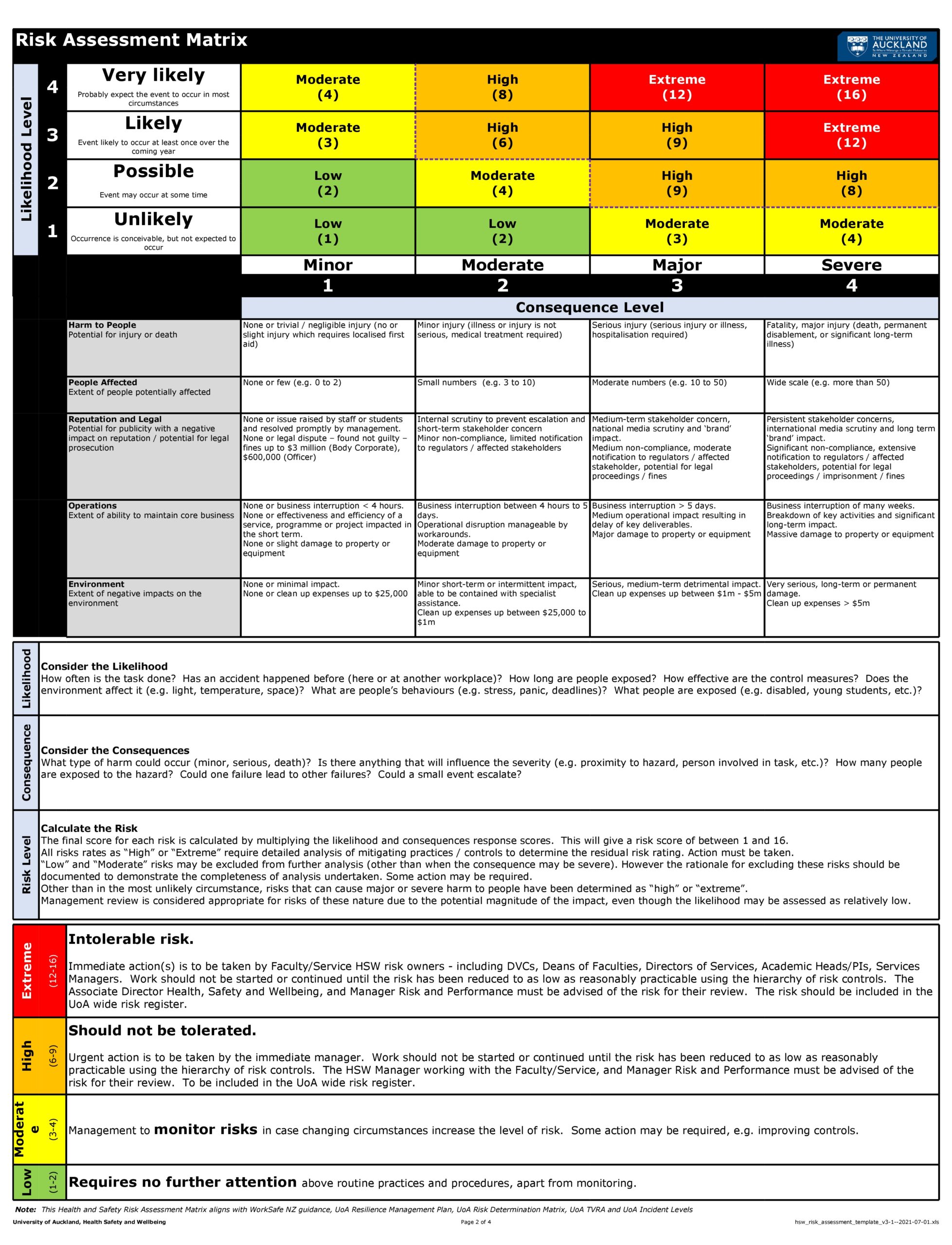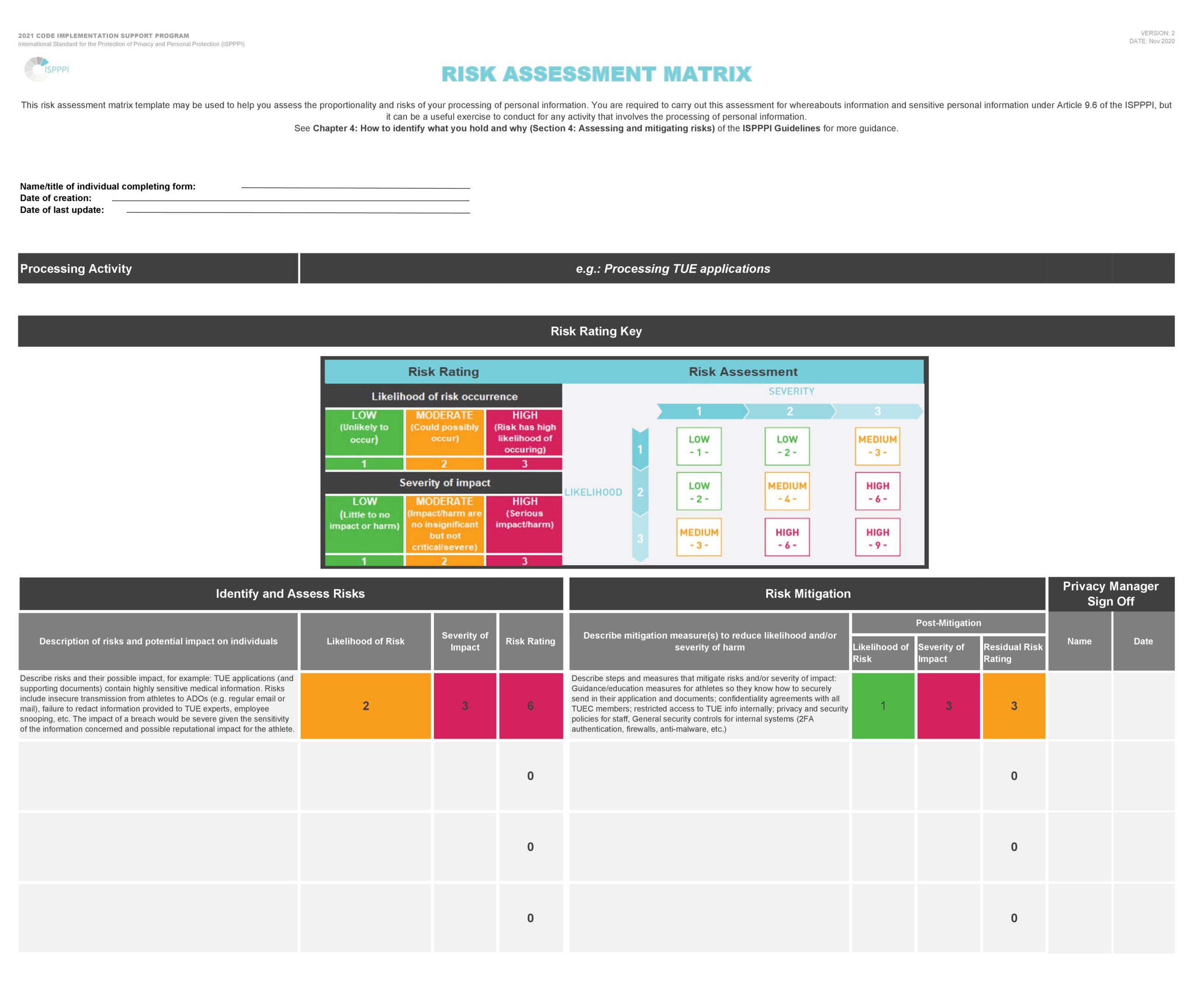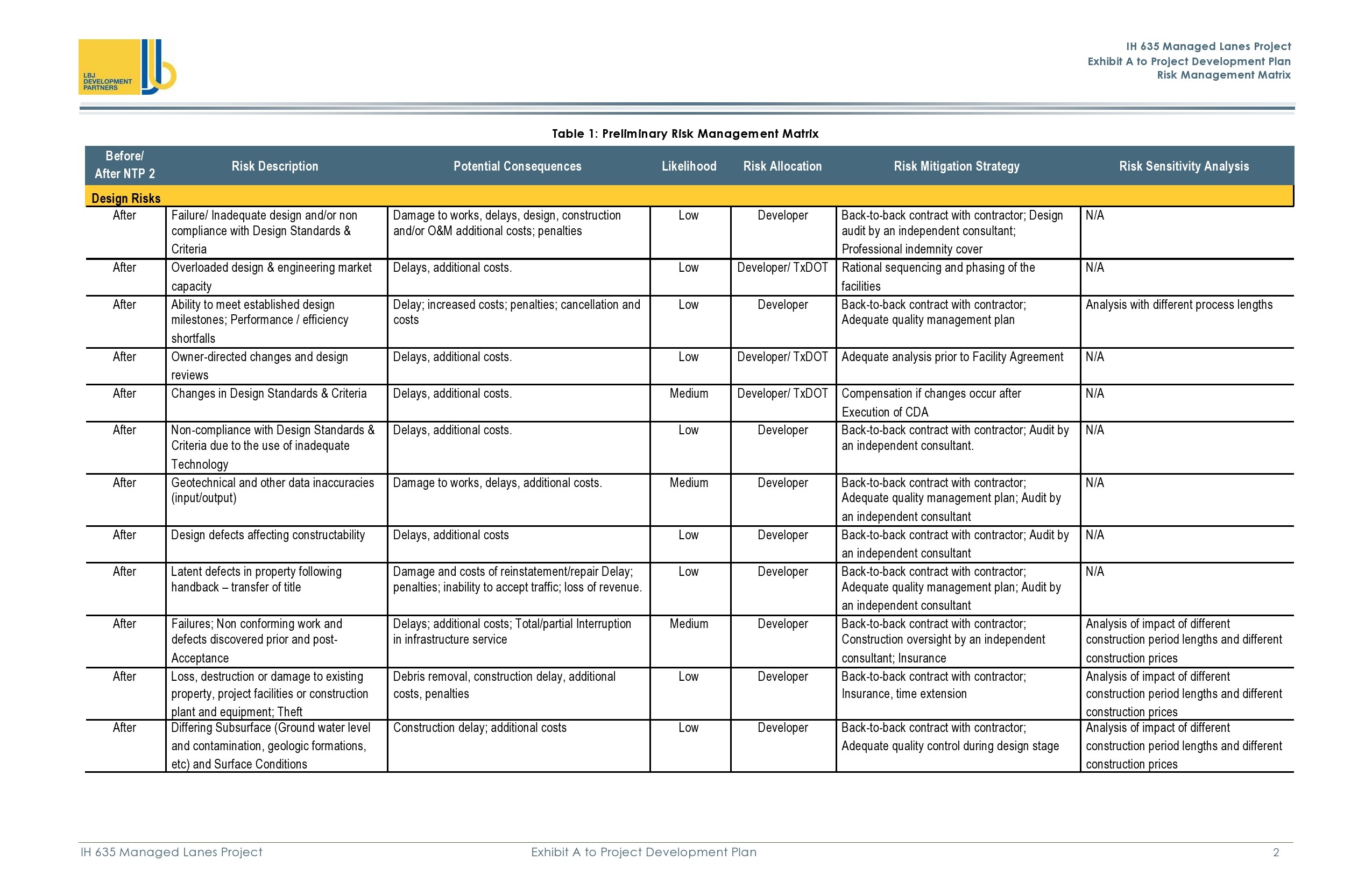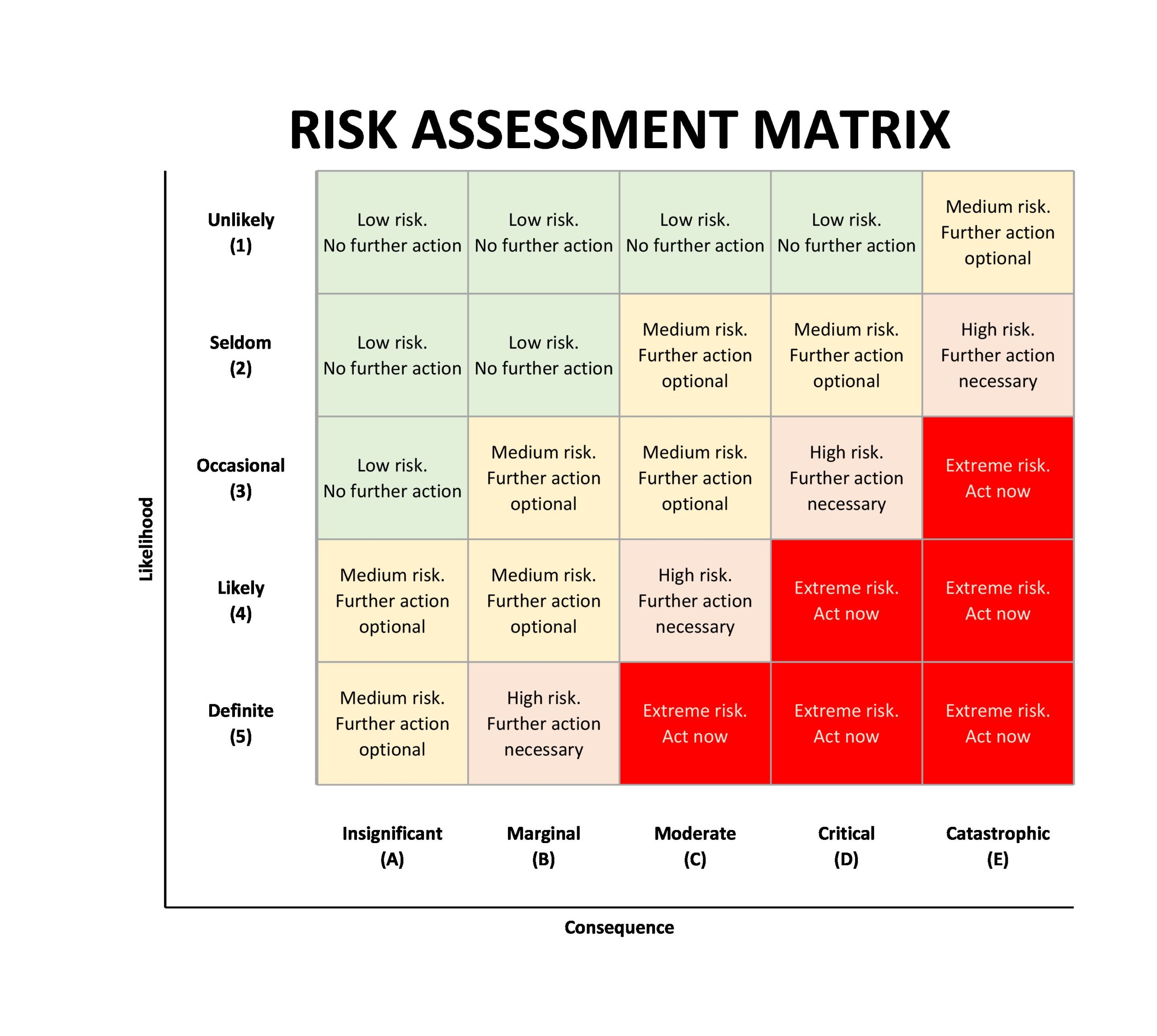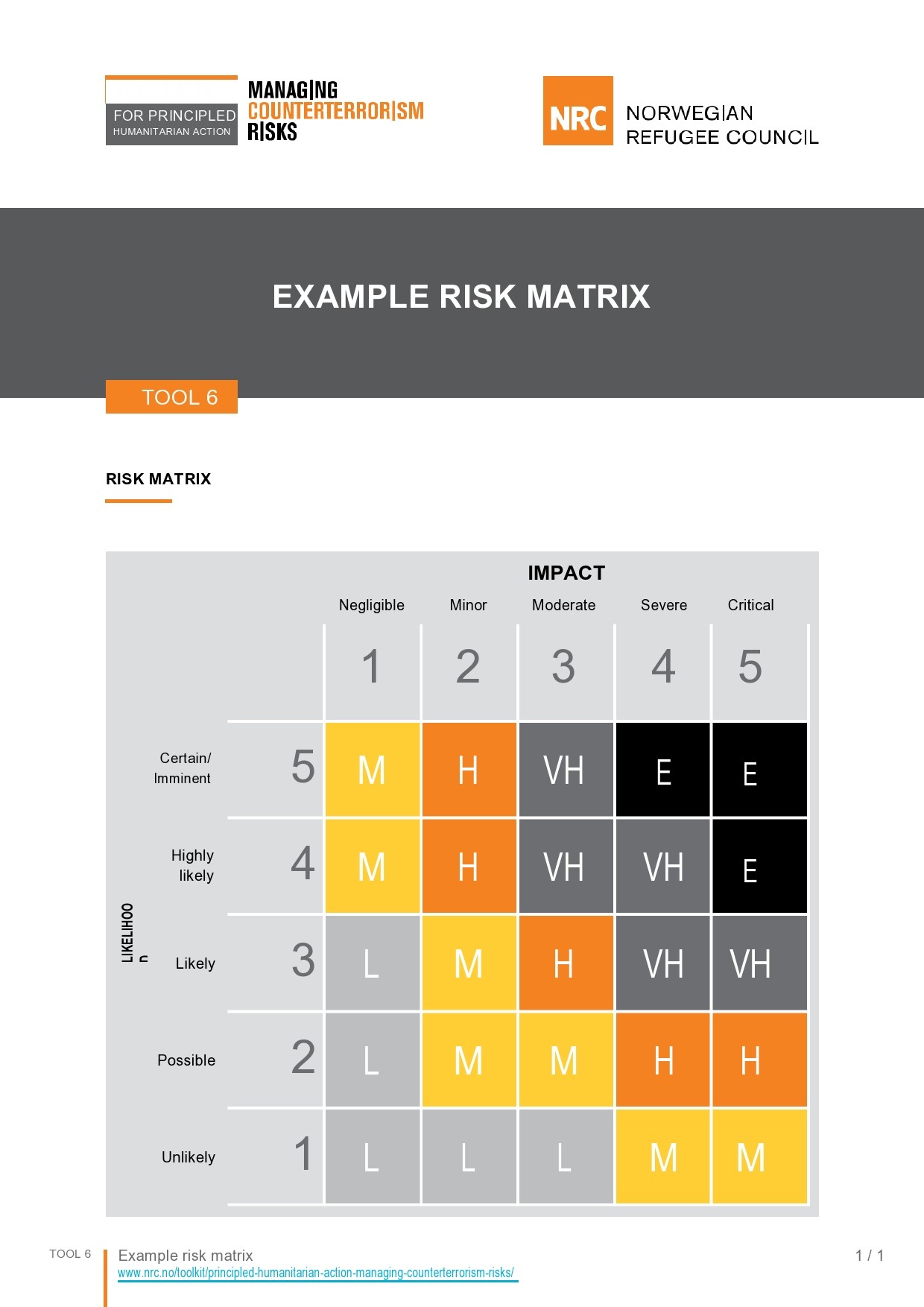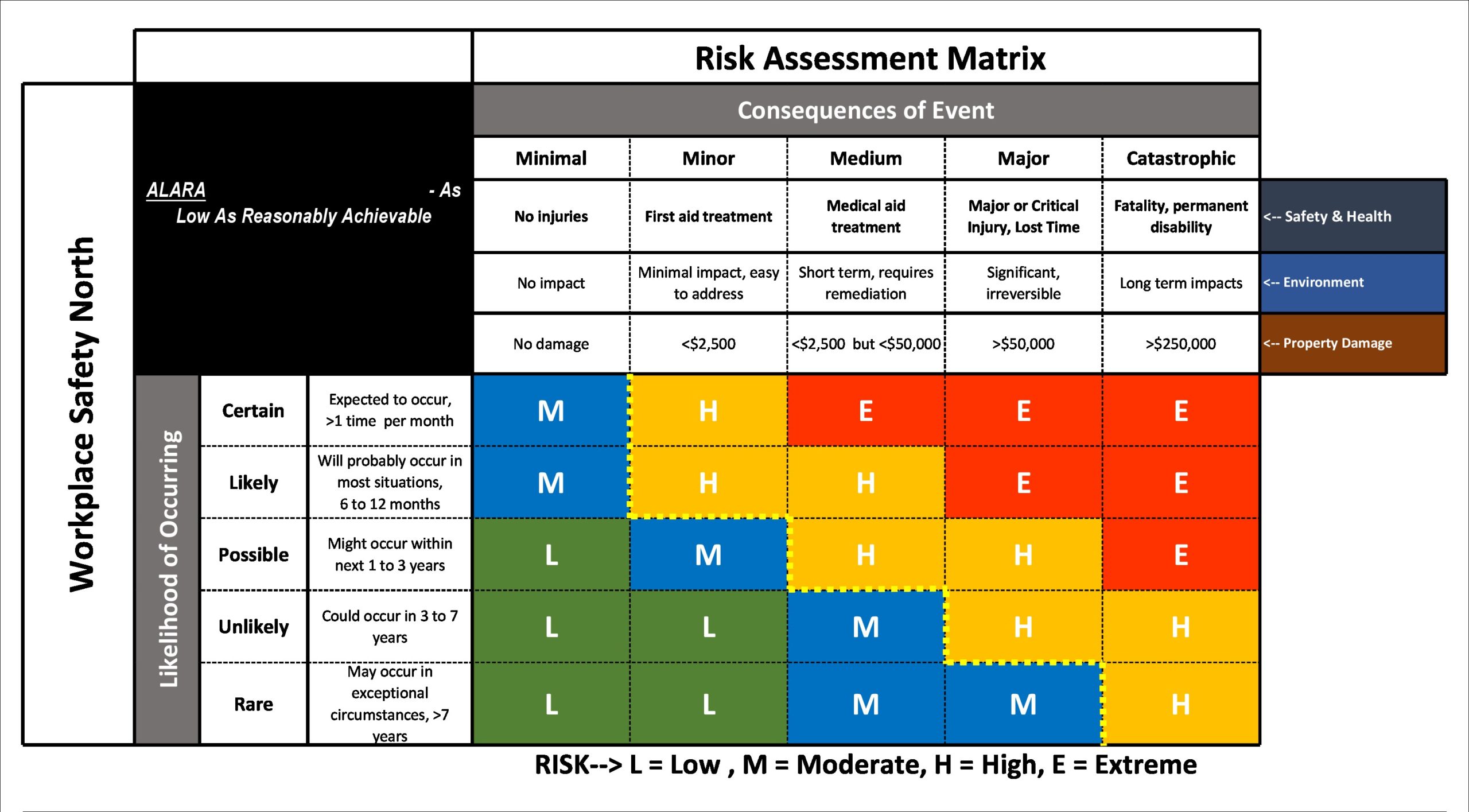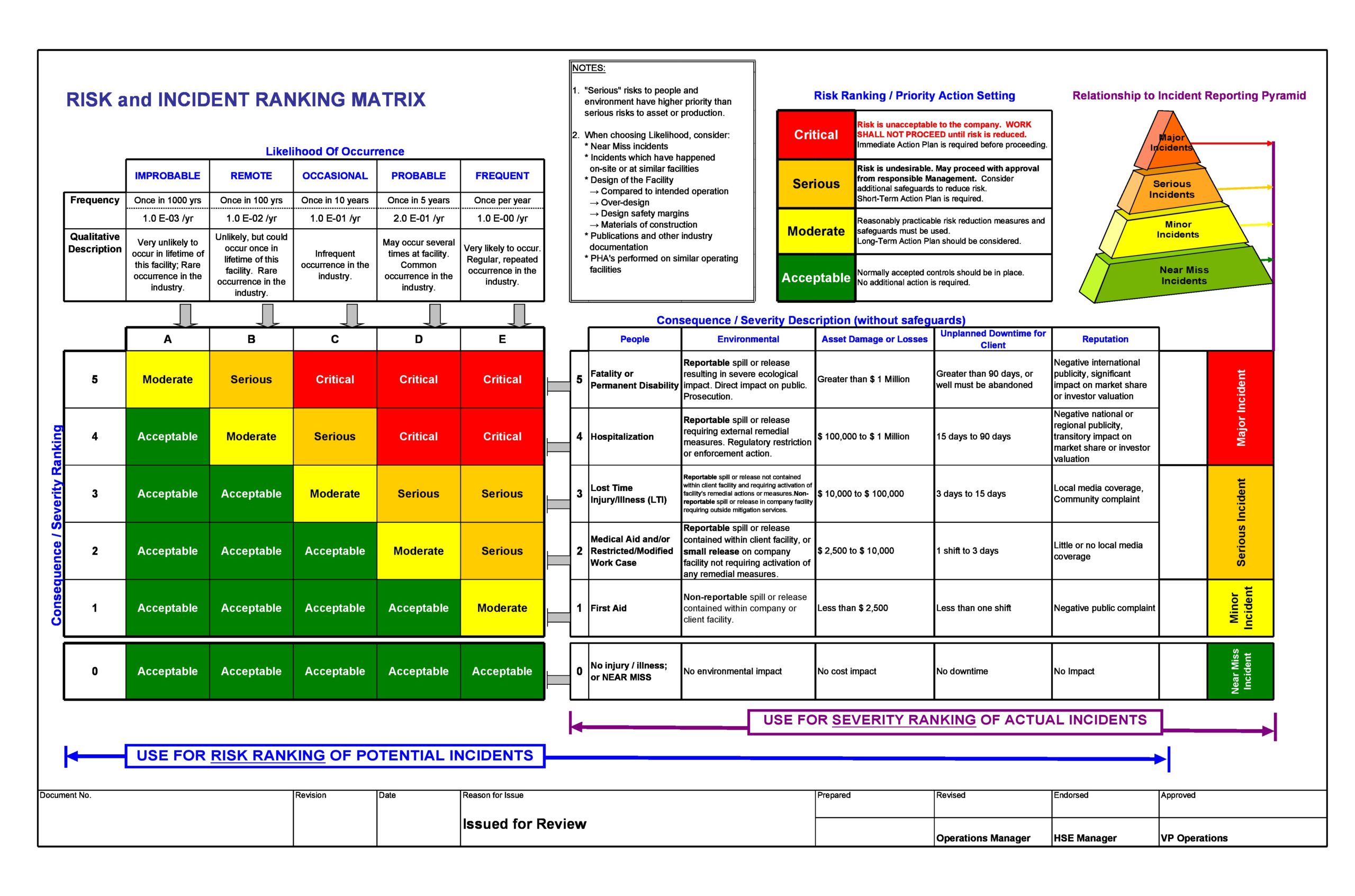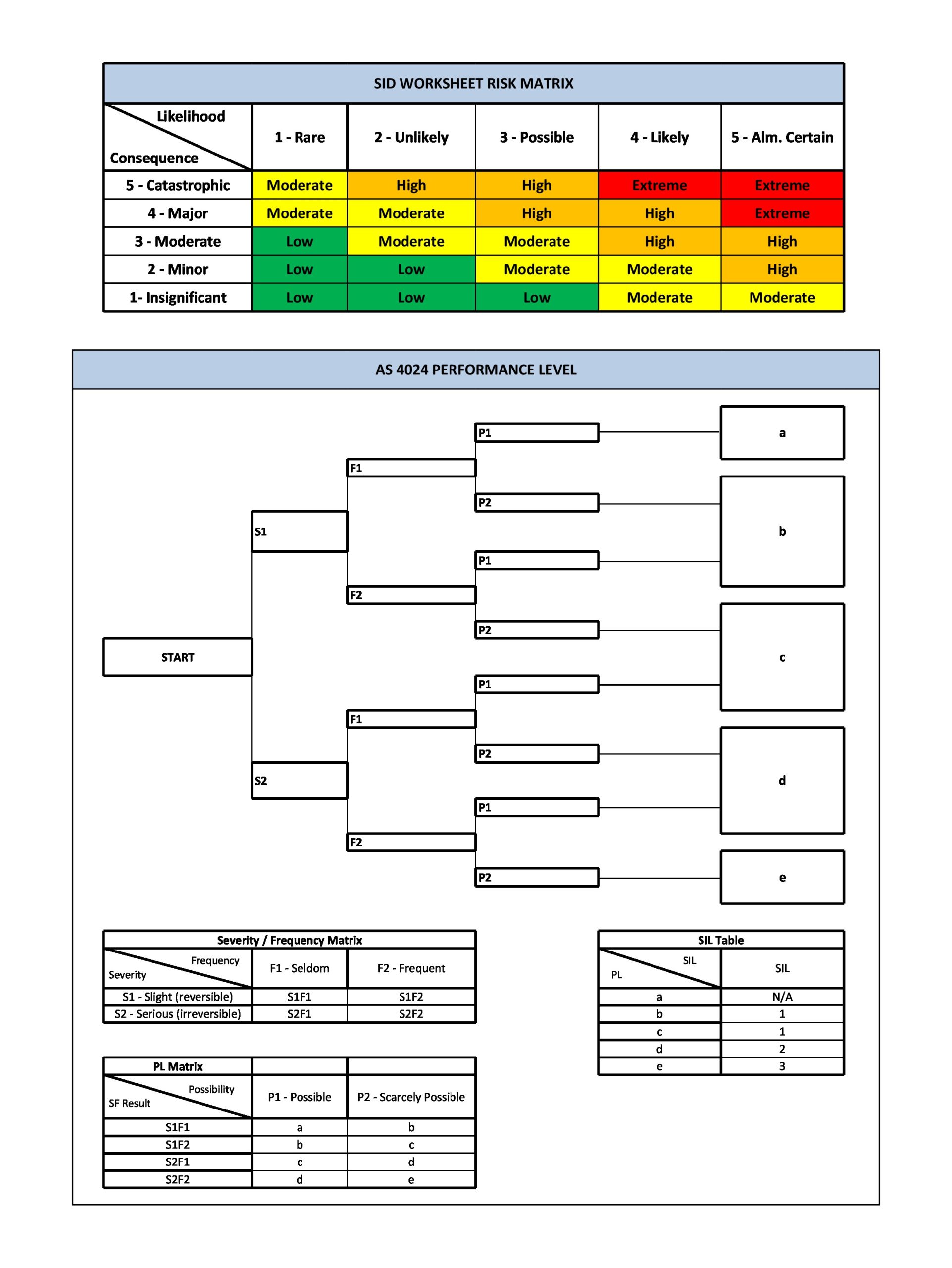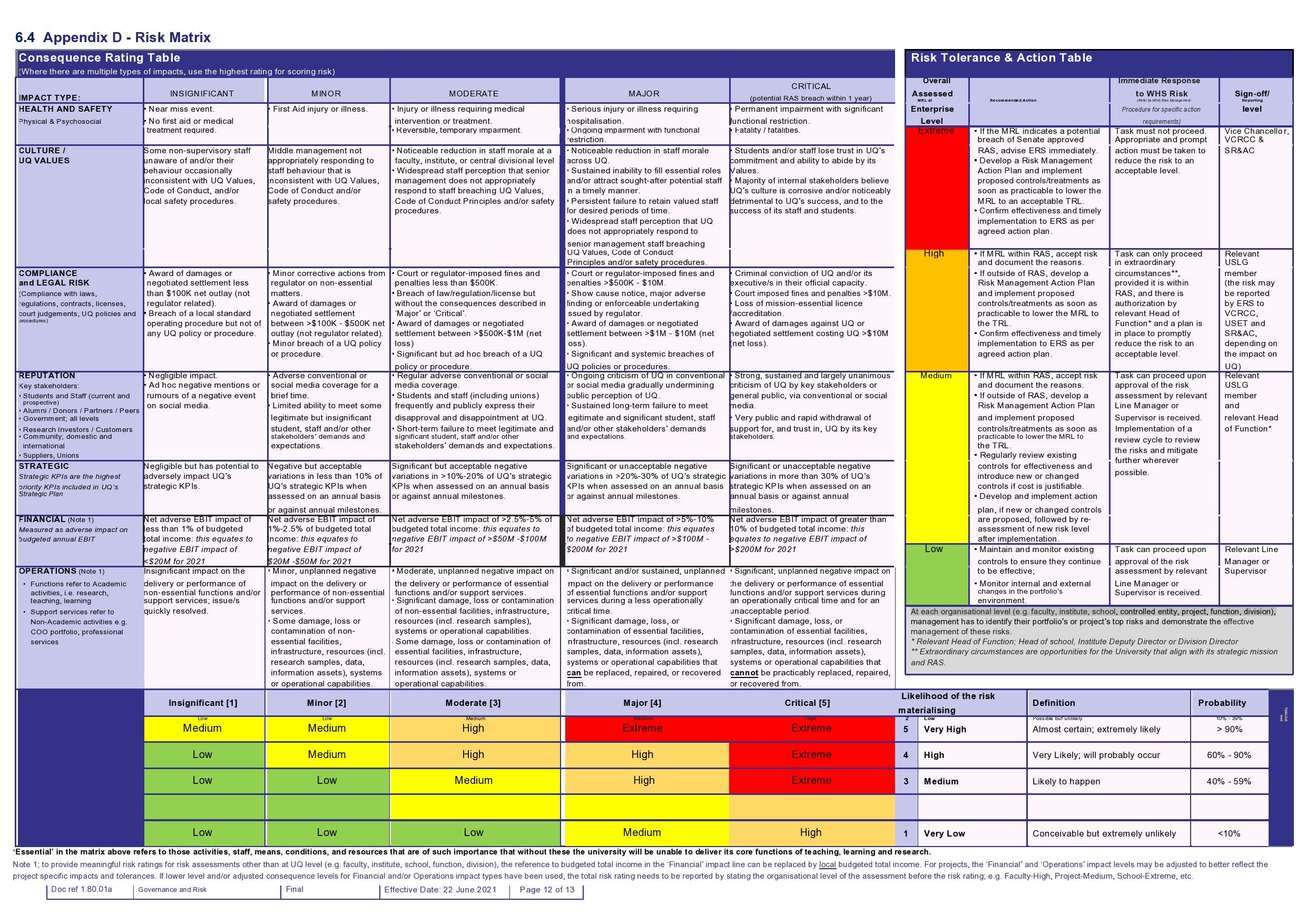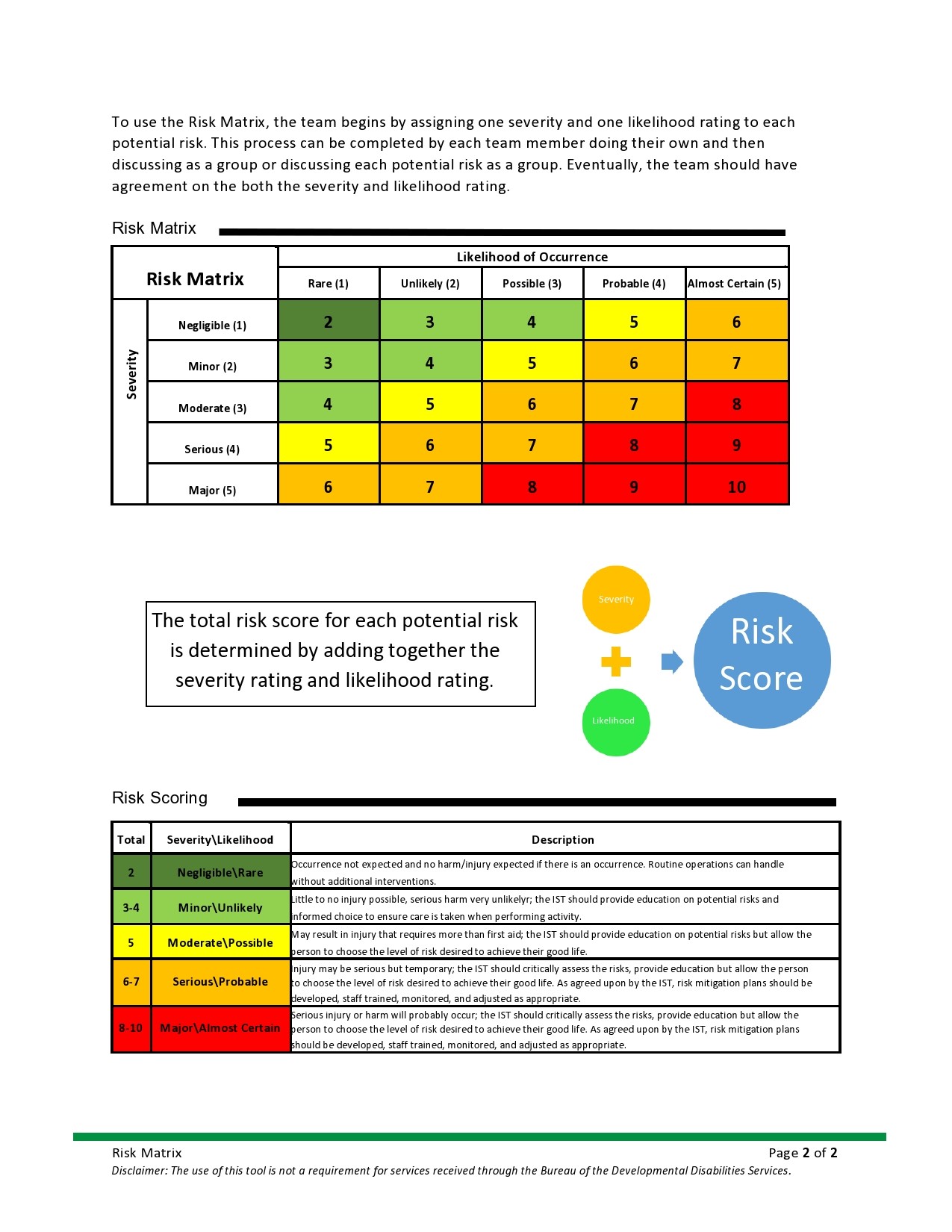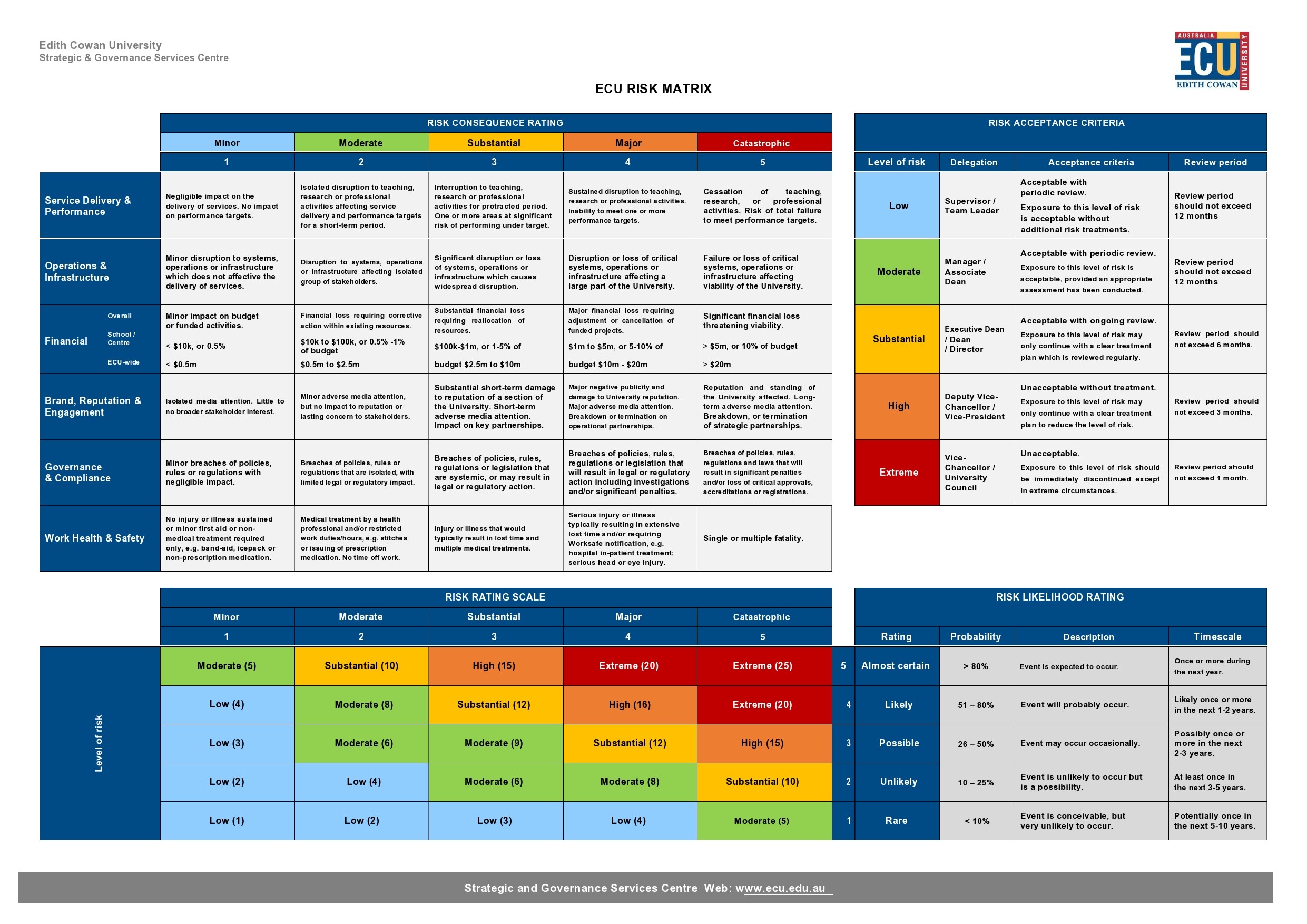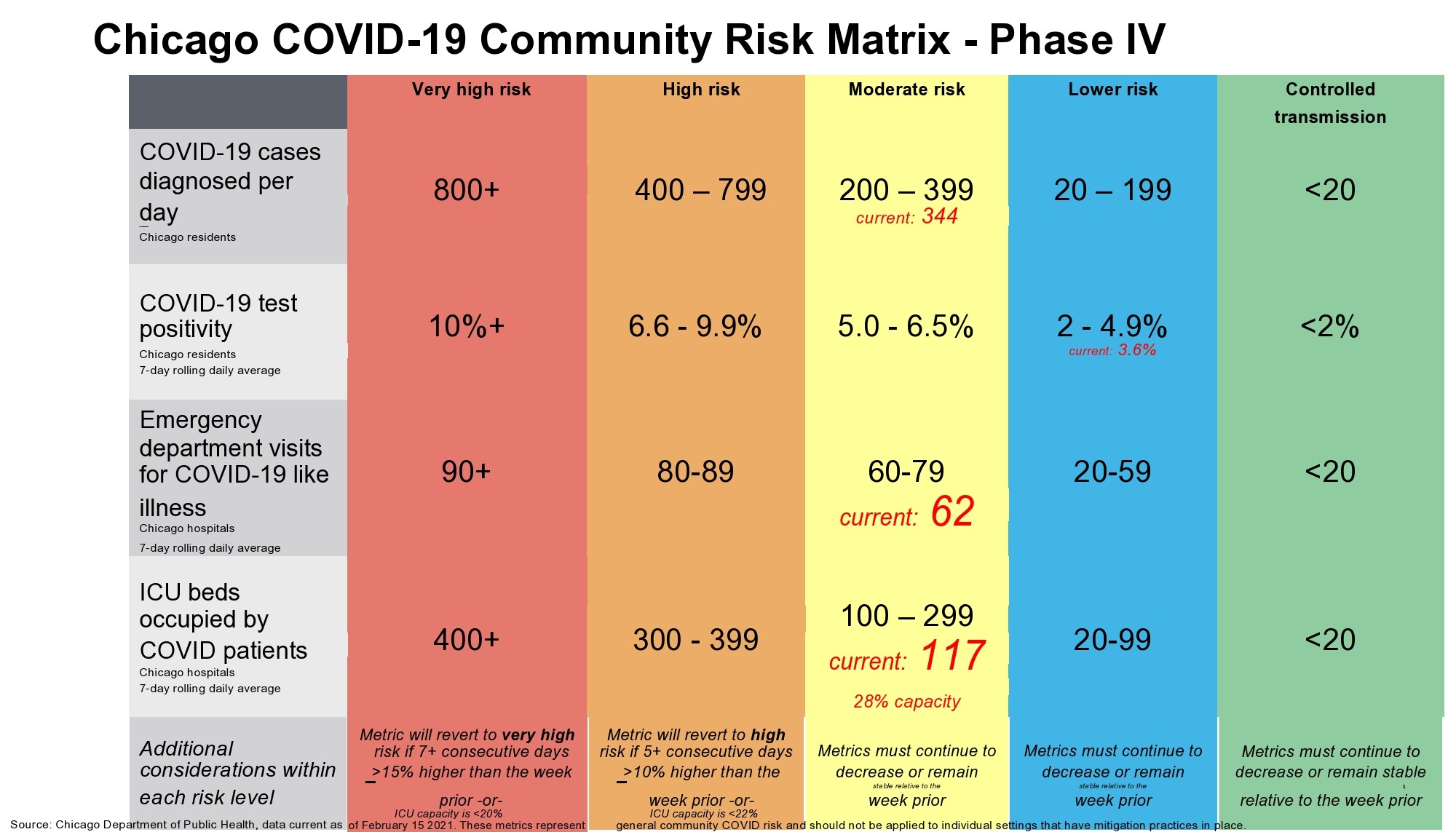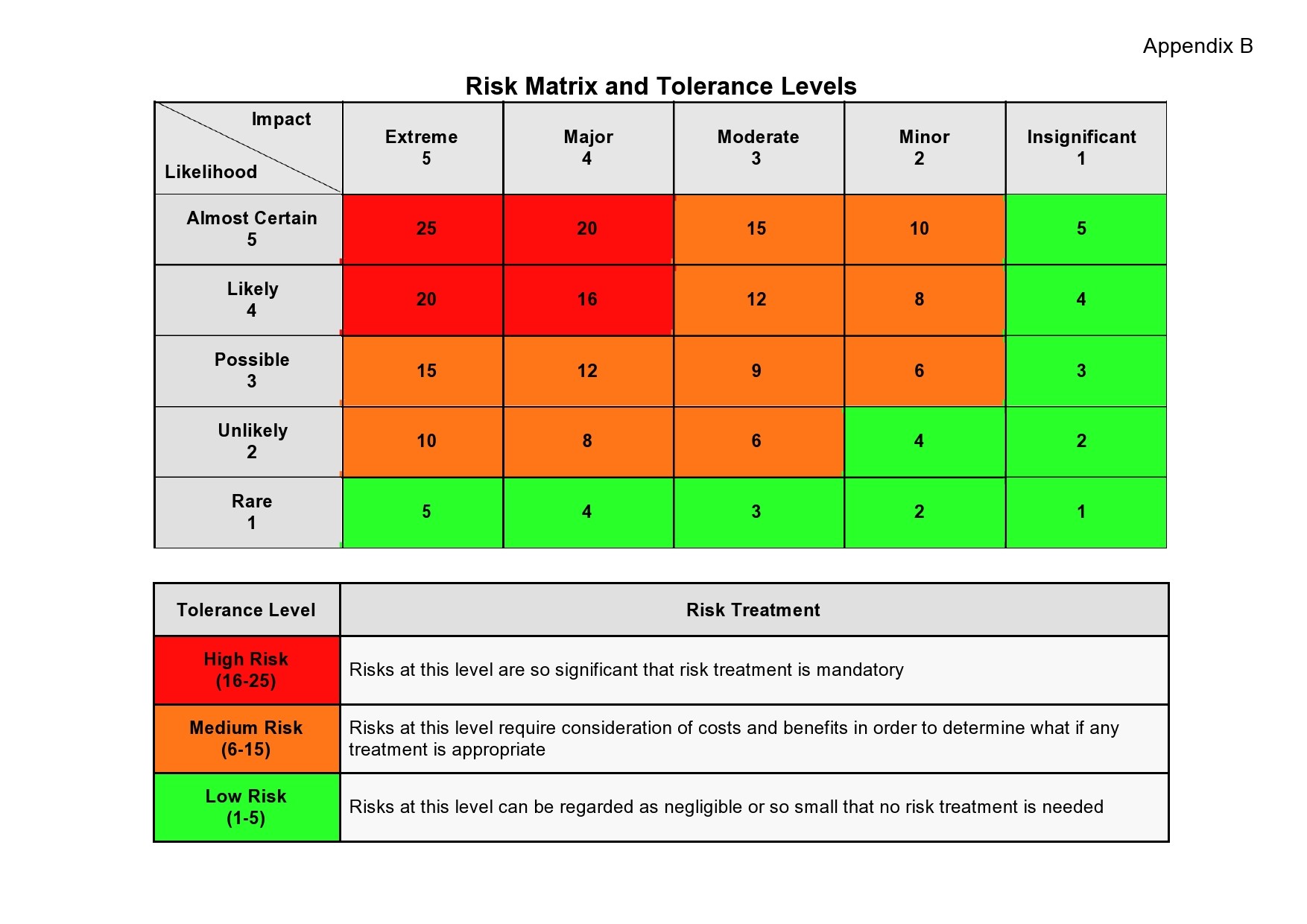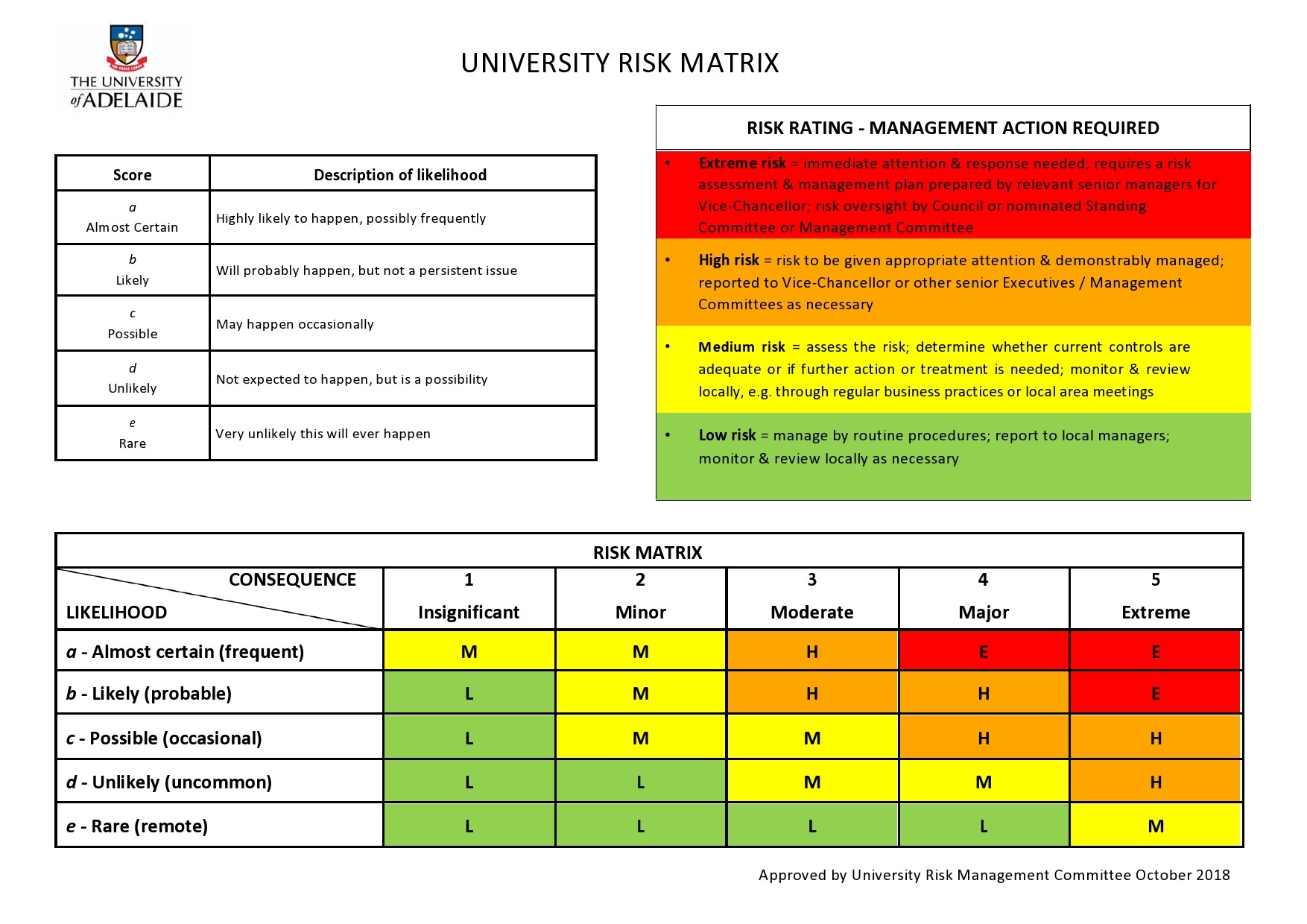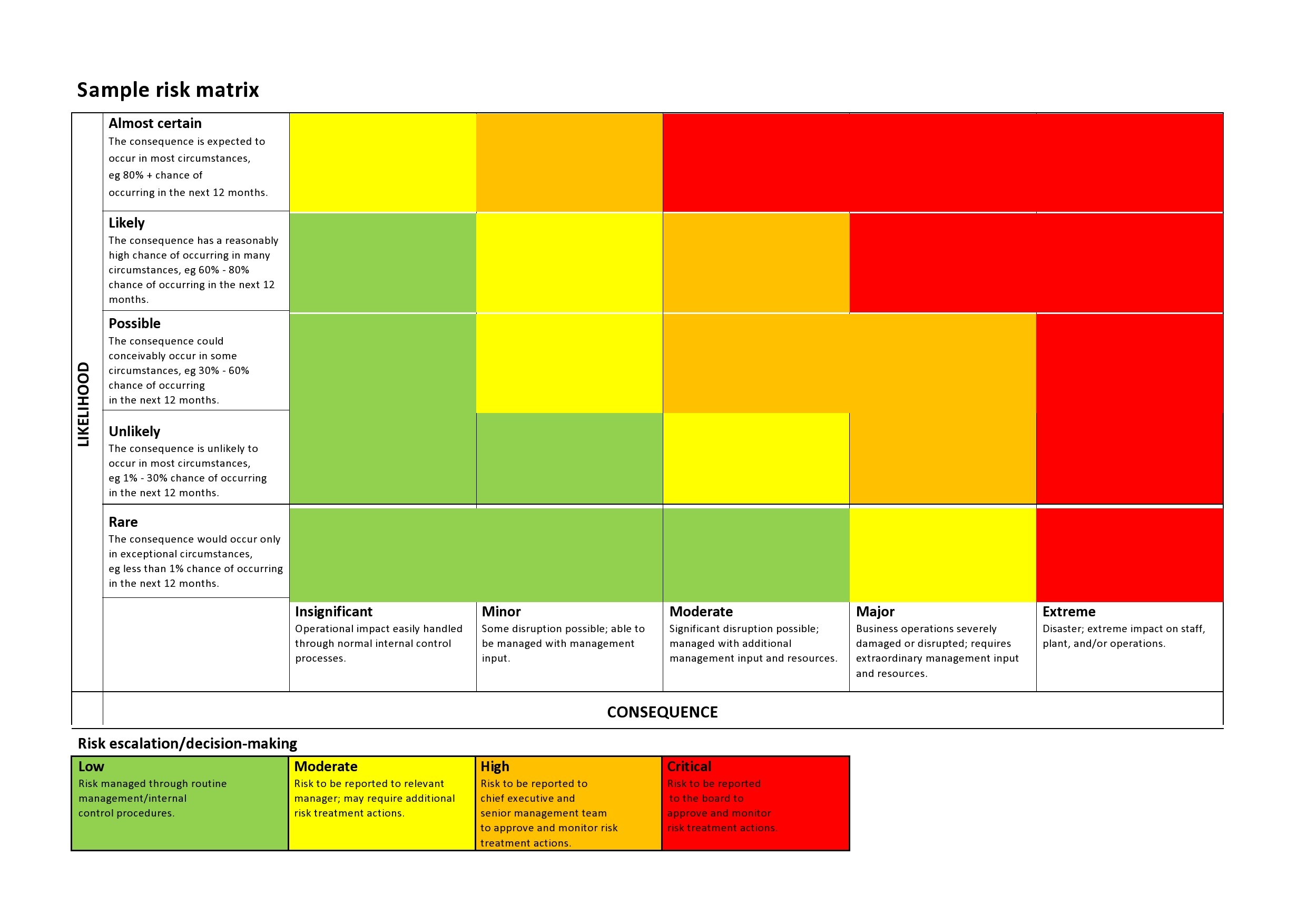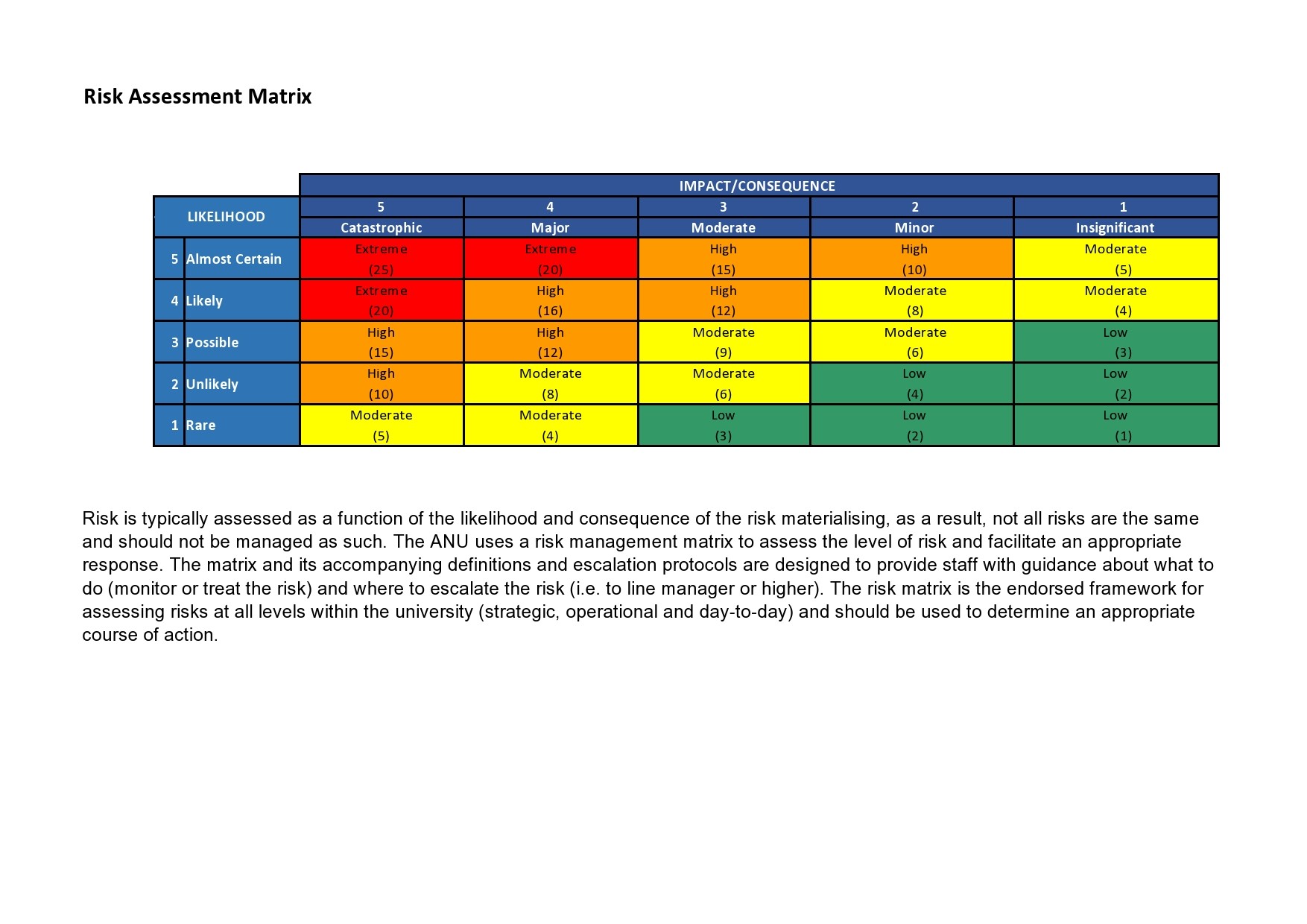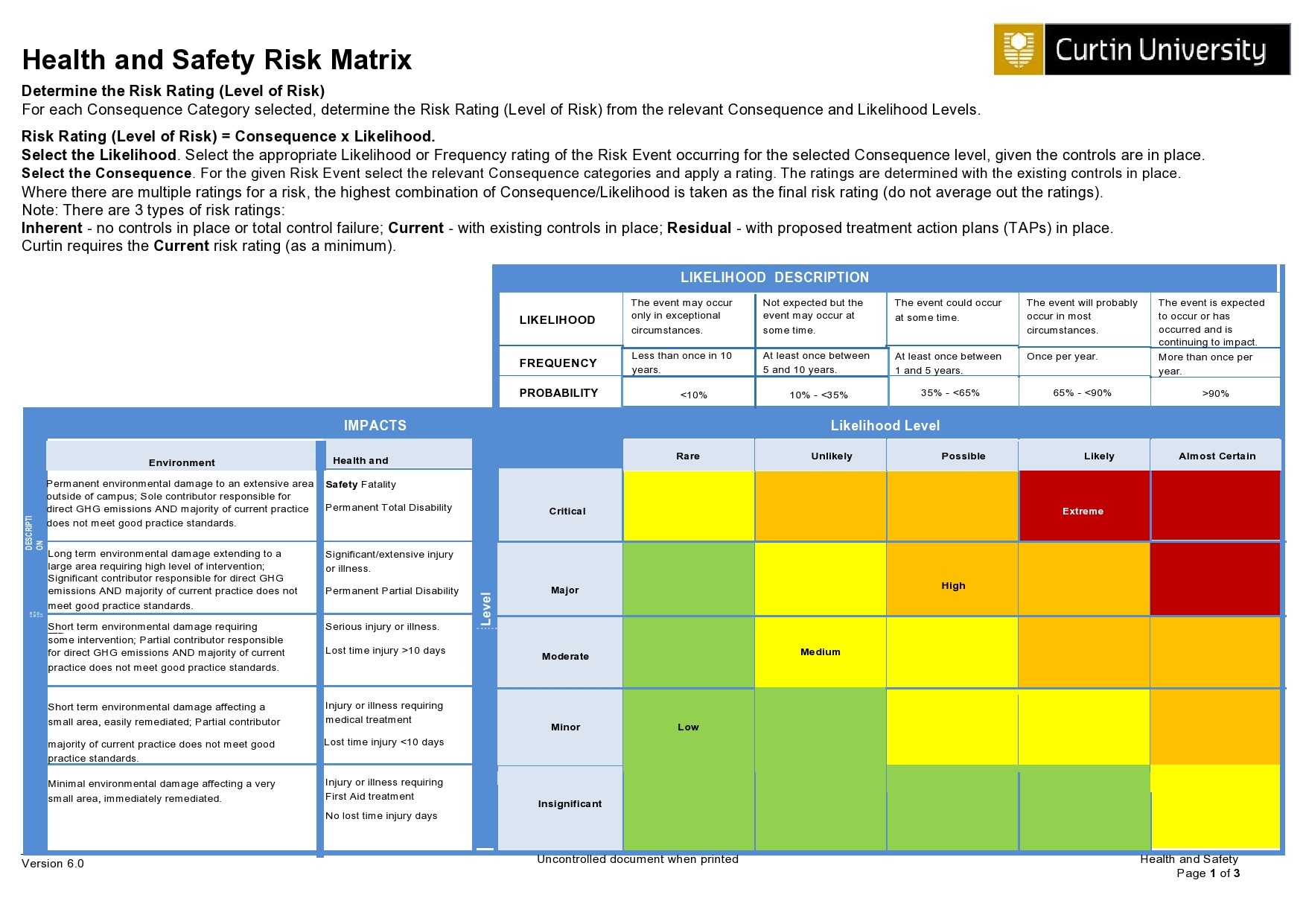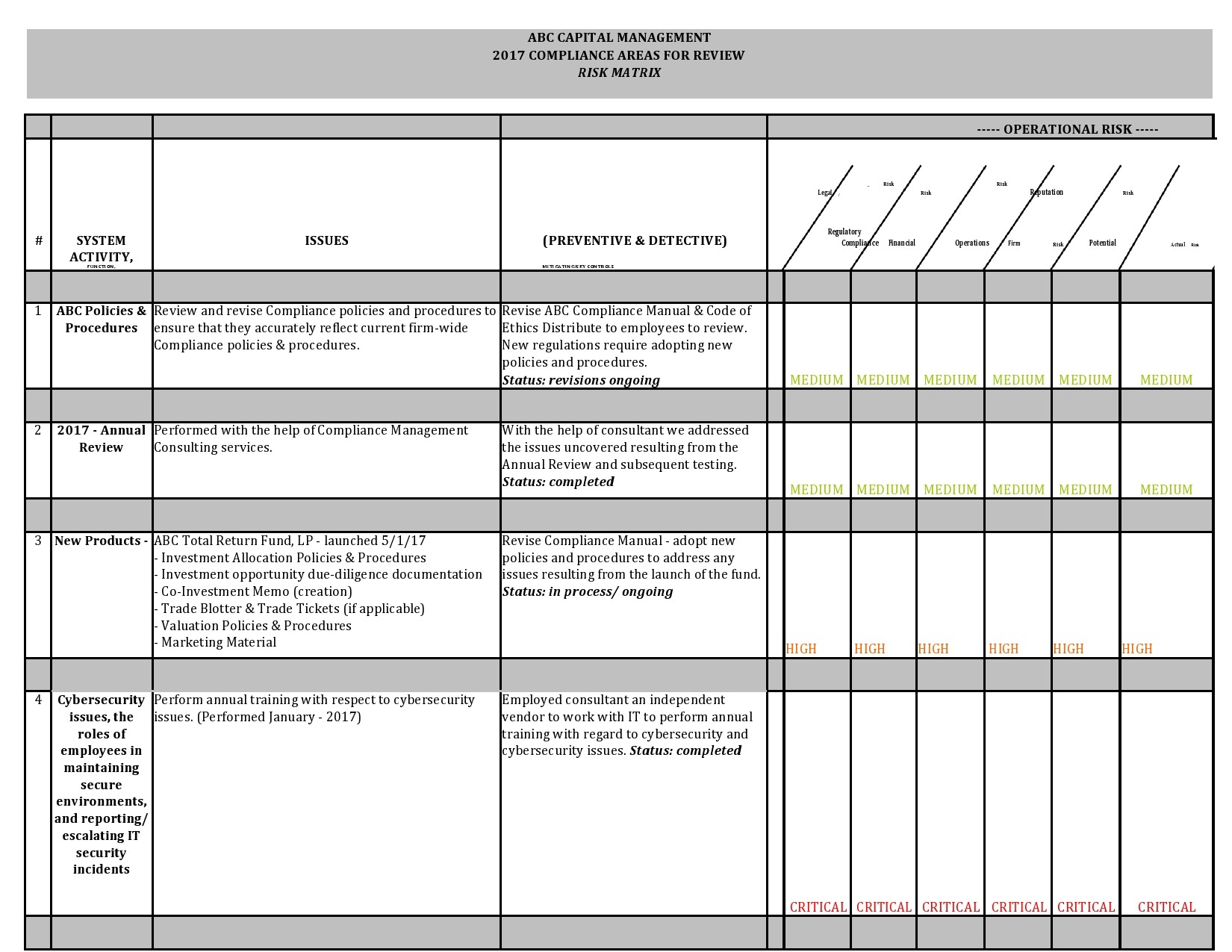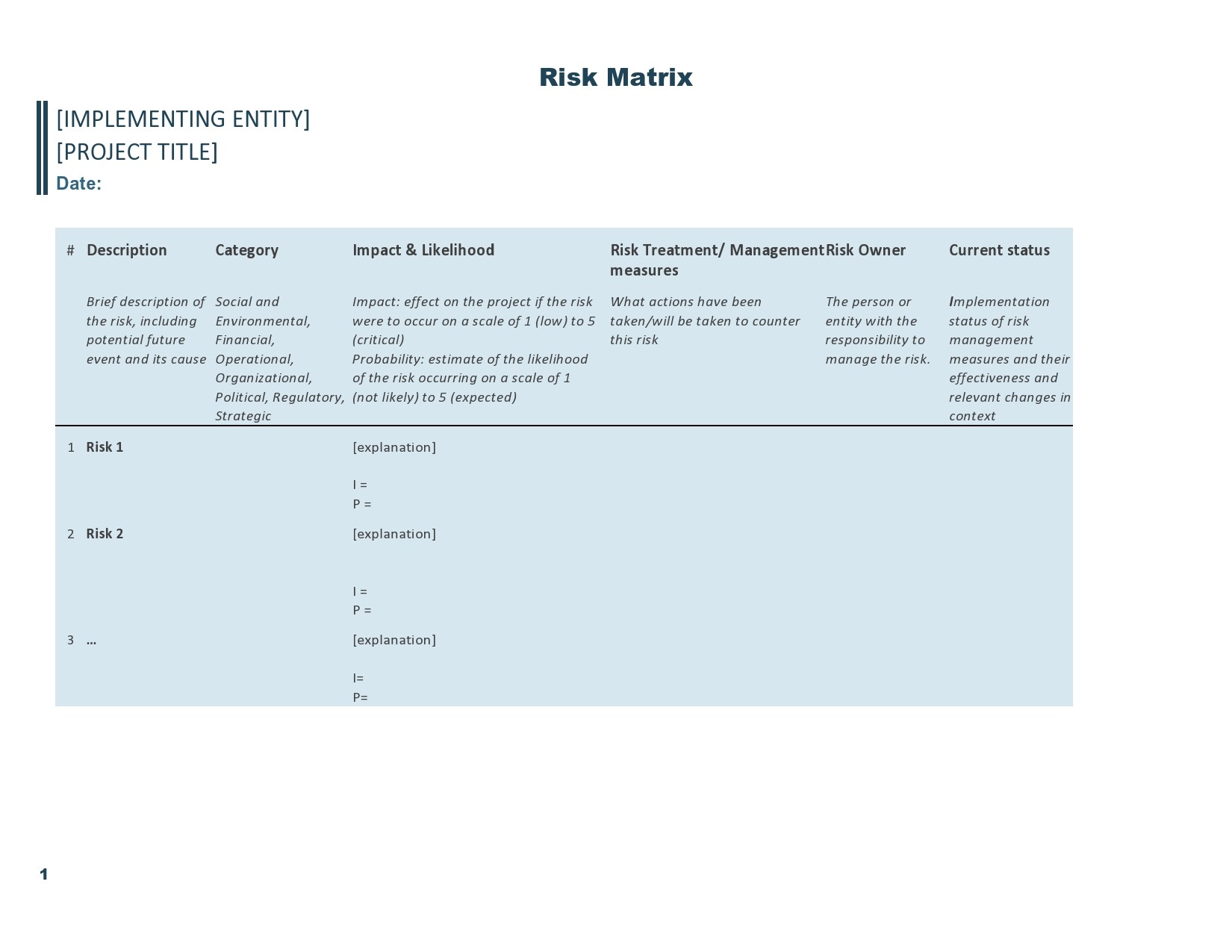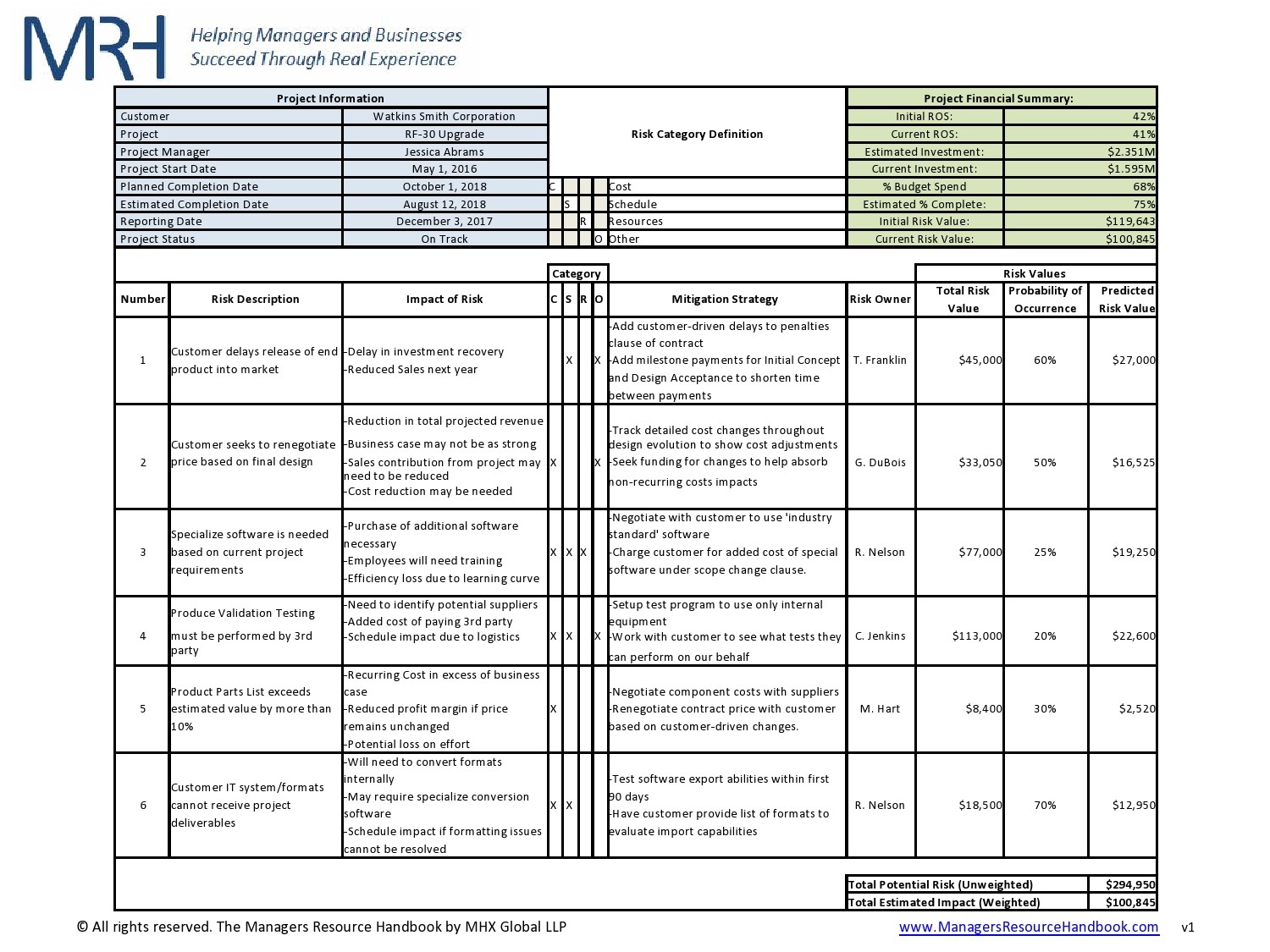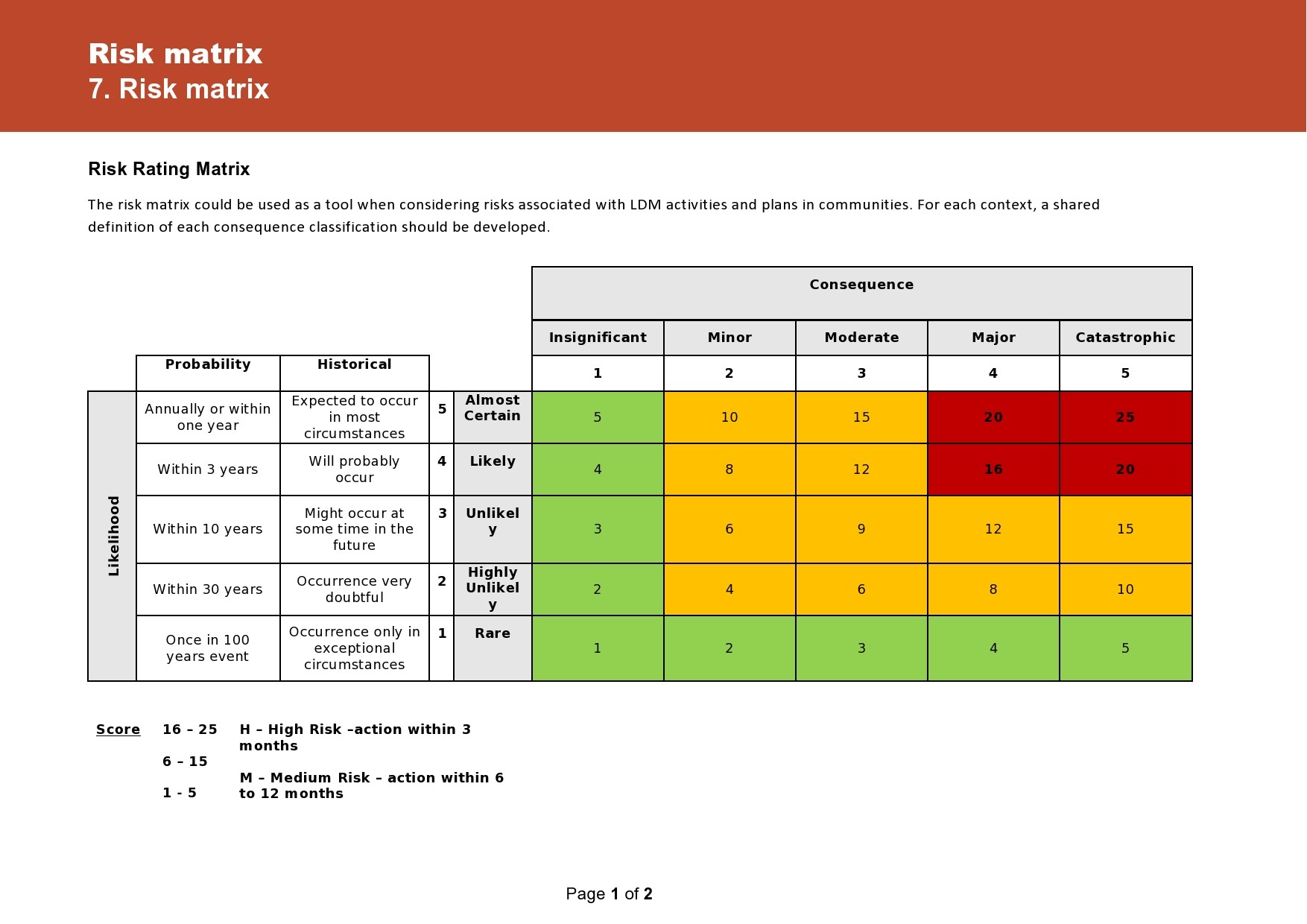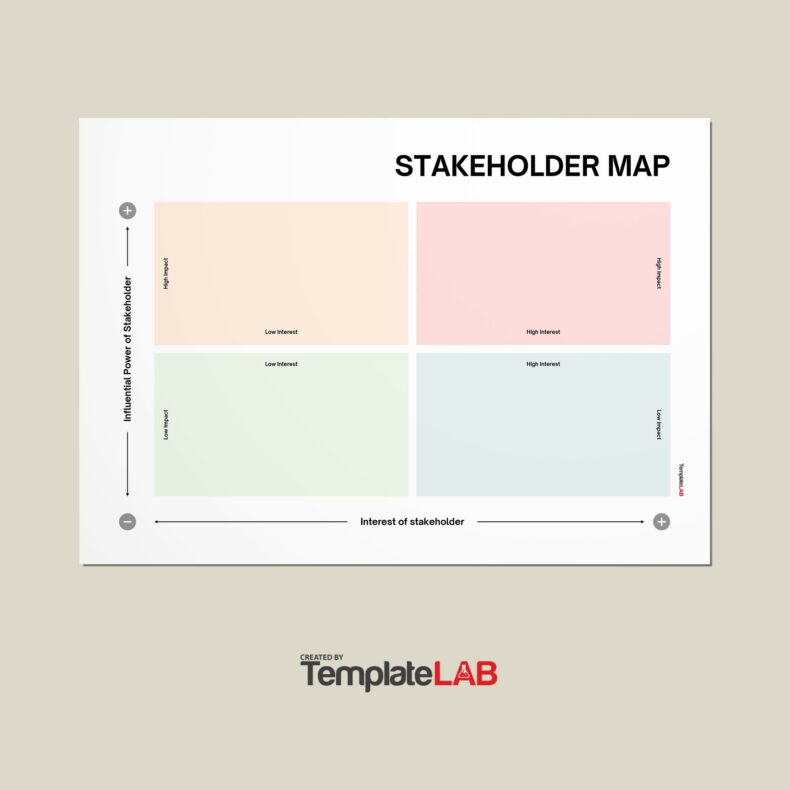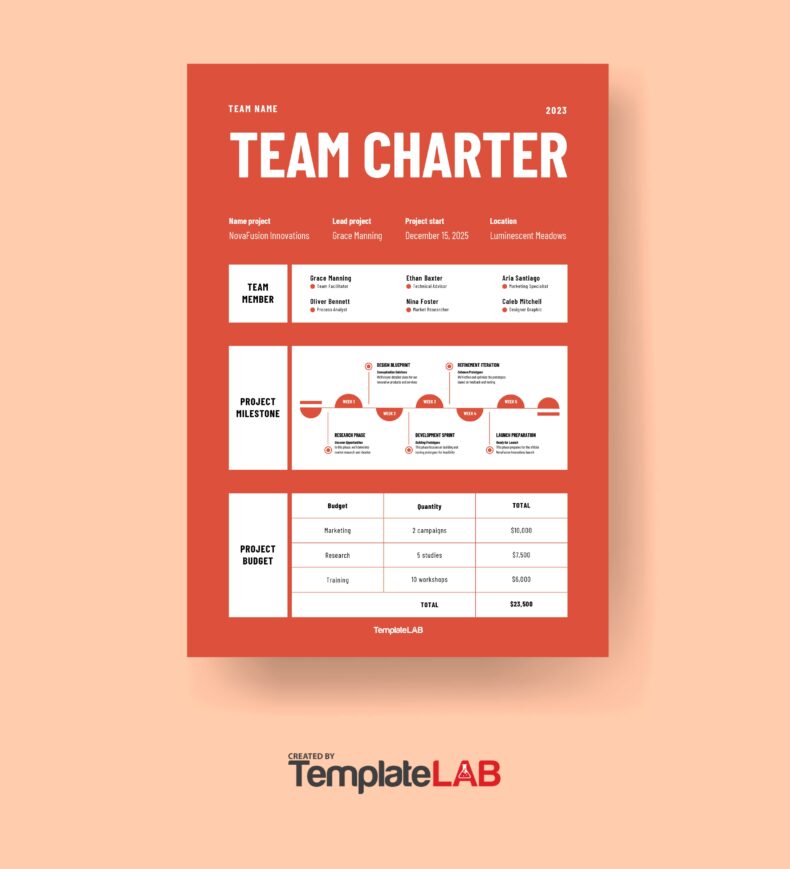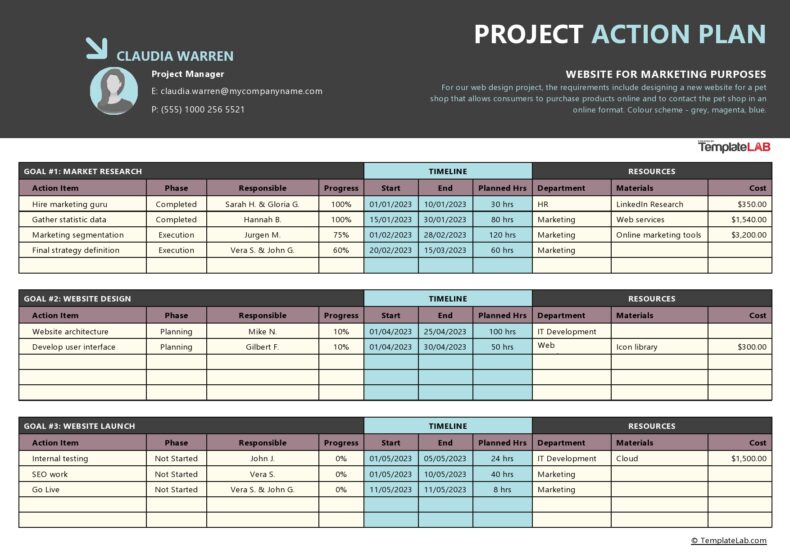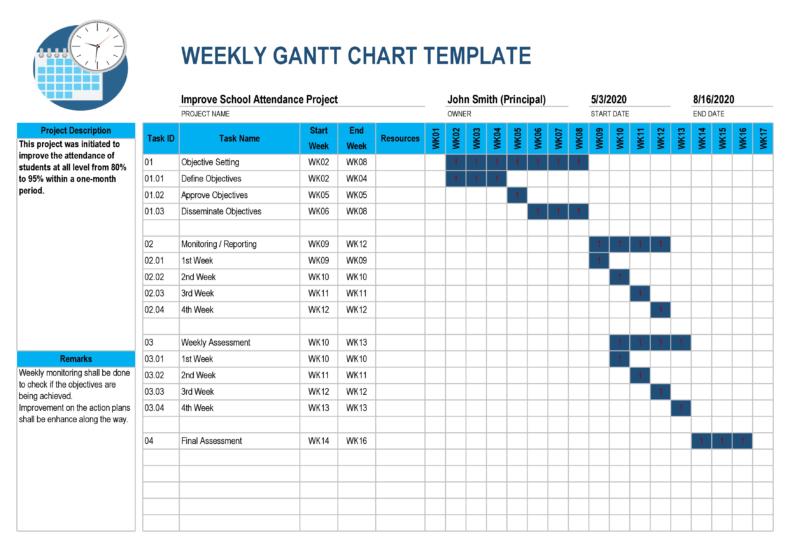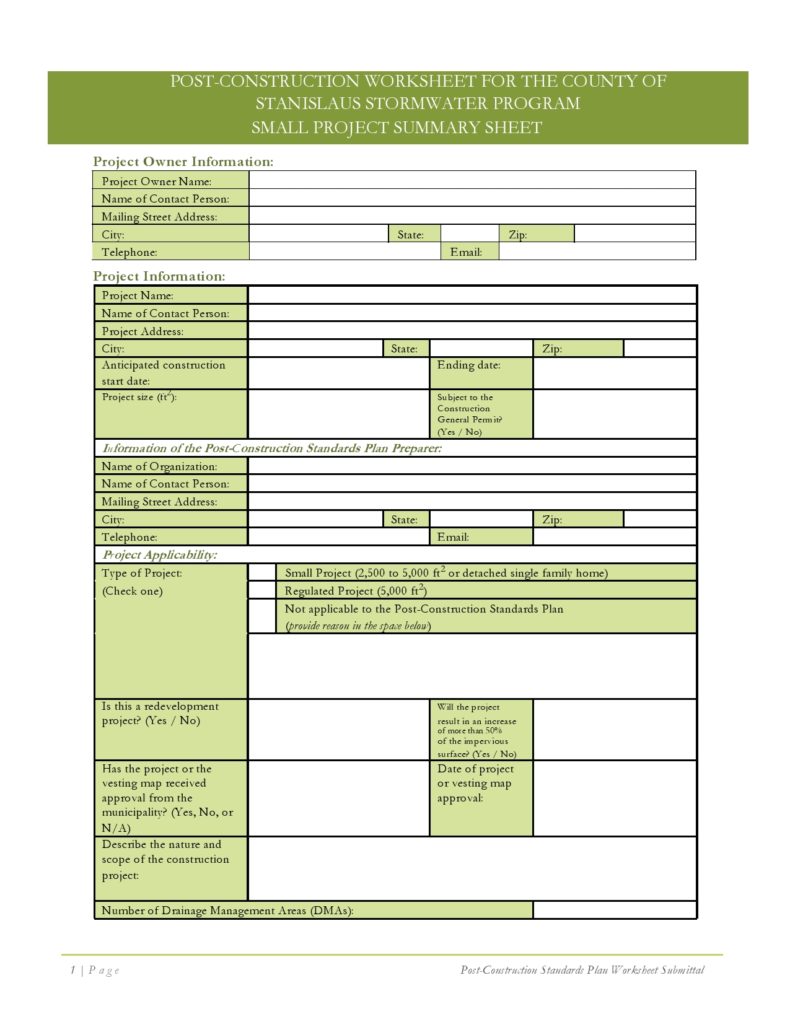Any type of project requires manpower, money, and equipment. At the starting phase, the people involved in running the project hope that all goes well until the final phase. Many times, projects do not end without issues. Something that hadn’t been anticipated will mostly happen. When it happens, it can either stall the project or significantly affect its profits, relationships, and timelines. It is possible to avoid or limit the effects if the risk is identified at the planning phase. A risk assessment matrix template is required to assess possible risks and plan mitigation strategies.
Table of Contents
- 1 Risk Matrix Templates
- 2 What is risk matrix?
- 3 Risk Assessment Matrix Templates
- 4 What are the benefits of a risk management matrix?
- 5 What does a risk matrix look like?
- 6 Risk Analysis Templates
- 7 How do you create a risk matrix?
- 8 Probability Impact Matrix Templates
- 9 Choice of colors in a risk matrix template
Risk Matrix Templates
What is risk matrix?
A risk matrix is also known as a risk diagram. It is a diagram that helps project managers visualize risks before a project starts. The project manager uses a risk assessment matrix template to divide the risks according to how likely they are to occur.
The template helps them measure the level of effect or damage extent they can cause to the project once they occur. If a certain risk in the risk assessment matrix template appears to have a greater risk, its case can be discussed and determined before the project starts.
The information in the risk assessment matrix template is the result of the risk analysis done and evaluated. Due to this, a risk matrix is a crucial component in any project.
Risk Assessment Matrix Templates
What are the benefits of a risk management matrix?
You could be wondering whether it is worth spending your time creating a risk analysis template. Spending time to assess risks could save your project a lot of money. It is advantageous to create a risk management matrix for all your projects during the planning phase. You will get a lot of benefits.
- You can save money
Sometimes it is hard to foresee a risk or challenge before a project starts. Once the project starts, issues can start to come up. Emerging risks in a project could easily escalate the overall project cost.
If you have assessed the risk through a risk management matrix, you might have identified it and prepared yourself to deal with it. Sometimes when the risk is higher, the project manager may decide to renegotiate the cost before the start of the project.
- You can save time
Emerging risks can be great time consumers causing project delays. For example, as the project is in its third phase, the project manager might realize they need specific equipment or talent.
The equipment might not be available locally, prompting importation. It takes time to recruit a new expert for the project. The process might necessitate the project to stop until the equipment arrives or the expert is hired. If the project had created a risk management matrix, it could have helped them foresee the risk and get prepared.
- It helps maintain healthy relationships with clients
The client is the key to business growth and sustainability. A project manager should do everything possible within their power to maintain healthy client relationships. One of the ways to help them achieve this is to create a risk management matrix to help them assess risks.
They can either notify the client about the risk in advance or renegotiate the cost. When there are ways to mitigate the risks, the project manager will save money and time, and their client will be happy.
- The project manager can prioritize the risks
Each risk will have a different level of severity. Some will be more severe, while others will have little impact on the project. To help them determine how severe each risk is, a project manager designs a probability impact matrix template.
This way, they can prioritize the risks according to severity. Some types of risks may occur multiple times throughout the project phase. Prioritization helps the project manager track the risks in case something goes wrong.
- A risk management matrix helps minimize the impact if the risk occurs
When an unexpected risk occurs in a project, the impact can be severe. It makes an entire difference when the risk is identified before the project starts. The project manager and his team will be ready for it with the necessary precautions.
If the risk occurs, its impact can be significantly reduced. The project manager and his team will be hoping for the best for the project, but they will be prepared for the worst.
- A project manager will set aside resources to deal with the risk
In any type of project, it might be impossible to foresee all risks. However, it is possible to plan for the possible risks if you are aware of how likely they can happen. It is an opportunity for the project manager to plan for action for anything unexpected. Planning for risks is an advantage to the project’s successful completion.
What does a risk matrix look like?
There are different types of risk matrixes, but there is no big difference in their design. The commonest used risk assessment matrix template is the 5×5 risk matrix template. On one side, it shows the probability or likelihood of a risk occurring. On the other side, it shows the impact or severity of the risk can have on the project. The 5×5 risk matrix template provides the following details.
The project manager first identifies the severity and likelihood of each risk. The 5×5 risk matrix template is divided into different tables with different colors. After identifying the severity and likelihood, the project manager inserts it in the probability impact matrix template accordingly. The final matrix will contain the following details.
- Risk severity
The section on risk severity ranks them according to the impact they can cause on the project. Some risks can have a severe impact, while others will have an insignificant impact. The severity ranking in the probability impact matrix template will be inserted as follows.
- Catastrophic impact: The catastrophic impact is extreme. When a risk is recorded as catastrophic, it means the impact it can cause on the project could lead to unfortunate collapse. This is the highest kind of risk that must be addressed before the project starts.
- Critical risk impact: The critical risk impact will have a substantial impact on the project but is not as serious as catastrophic. It might lead to installing of the project, but serious mitigation measures should be taken.
- Moderate risk impact: The moderate risk impact can cause a potential impact on the project. However, it is easy to mitigate it. It can cause a little delay or potential impact on the overall project cost.
- Minor risk impact: The minor impact risk is likely to occur, but it will have minimal impact on the project. If no mitigation plans are in place, a minor risk can easily escalate into a more severe risk.
- Insignificant risk impact: Insignificant risks may happen, but the consequences caused to the project will not be significant.
The likelihood of a risk occurring
After the project manager records in the 5×5 risk matrix template the severity of a risk, their next action is to record the likelihood of happening. A risk could be severe but have little likelihood of occurring. Another one could be moderate but have a higher likelihood of occurring. They are ranked in the 5×5 risk matrix template as follows.
- Definite: This is the type of risk that cannot be escaped. It will for sure occur during the project phases. This is the type of risk that must be prioritized and addressed first.
- Likely: The risk can occur, but its likelihood is not high. The project manager prepares his team to handle it if it occurs.
- Occasional: During the project time, this type of risk may occur 50 percent of the time. The team must be prepared to handle it if it occurs.
- Seldom: There is a minor chance the risk may occur. The chances of it occurring are almost zero.
- Unlikely: The chances of this risk occurring are extremely rare. Likely, it will never occur.
Risk Analysis Templates
How do you create a risk matrix?
Sometimes it is hard to predict how soon a risk can occur or the level of impact it will cause. At one time, it may occur sooner than anticipated. At another time, the impact can be more severe than initially imagined. All in all, a project manager should be prepared by assessing all risks and recording them in a probability impact matrix template.
The process of creating a probability impact matrix is simple. The manager can download an excel risk assessment template and begin to fill in the details. These are the main steps when creating a risk matrix.
- Identify the risk
The type of risks a business faces today could be different from future risks. Due to this, the manager must create a detailed picture of the entire risk landscape. The manager may not do it alone, but they need the input of other key personnel.
The key thing is to hold brainstorming sessions with the key personnel for ideas and to generate a list of the main risks. The manager should involve a wide range of stakeholders to ensure nothing valuable is missed. The assessors should look deeply into every aspect of the project. In the brainstorming session, categorize the risks as follows:
- External risks:These are risks that no one can control or prevent from happening. They are also called non-human risk sources.
- Strategic risks:These are risks that result due to wrong business decisions during planning.
- Financial risks:They are risks resulting due to financing
- Operational risks:These are risks emanating from the internal processes or procedures.
Classify the risks starting with the high-level risks and narrow to low-level risks.
- Identify the risk criteria
By brainstorming on the risks, you have done a significant portion of the assessment. Next, identify the criteria you will use to evaluate each risk. If you revisit the excel risk assessment template, you will notice the risk matrices are divided into two:
- Their likelihood of occurring
- The impact they can cause
It is necessary for the team involved to agree on the classification criteria they will use. Be sure to accurately measure the risks so that you can create a plan for risk management.
- Analyze the risks
Following the criteria you have agreed on, begin to analyze the risks. Agree on the scale you shall use to do a qualitative risk analysis. Most project managers adopt a three-part scale analysis to assess the severity of each risk. The risk can either be:
- Low
- Medium
- High
The team can rate the risk on a scale of 1-5, where 1 means extremely low and 5 means extremely high. The middle of the scale will mean medium risk. Assessing and analyzing risks this way helps the company allocate resources accordingly.
- List the risks according to priorities
Before recording the risks in the excel risk assessment template, list them according to priority. From your list of low, medium, and high risks, list them in a likelihood criterion. Some will have a higher likelihood and others lower.
From the list of severity and likelihood, draw your plan for risk assessment that will help the entire team mitigate them effectively. Do not forget that risks are dynamic, and they keep evolving as time progresses.
After recording all the details in the excel risk assessment template, keep in mind that the template needs to be updated often. Every time the risk environment changes, refocus on the risks and update the template.
Probability Impact Matrix Templates
Choice of colors in a risk matrix template
The assessment team decides on the colors to use to mark each risk level. Many managers choose red, green, and yellow, although you are free to choose any color you feel comfortable with.
- Green: Green indicates low risks that may require little or no attention. On the lower-left corner, mark the risks that have low impact and low occurrence likelihood.
- Red:Red indicates risks that have a very high impact and are very likely to occur. These are the types of risks that require priority mitigation measures.
- Yellow: Yellow indicates risks with medium impact. They are likely to occur and cause an impact on the business. They are allocated resources to mitigate them if they occur. If they are not mitigated, they can cause project delays, or their costs could go overboard.

